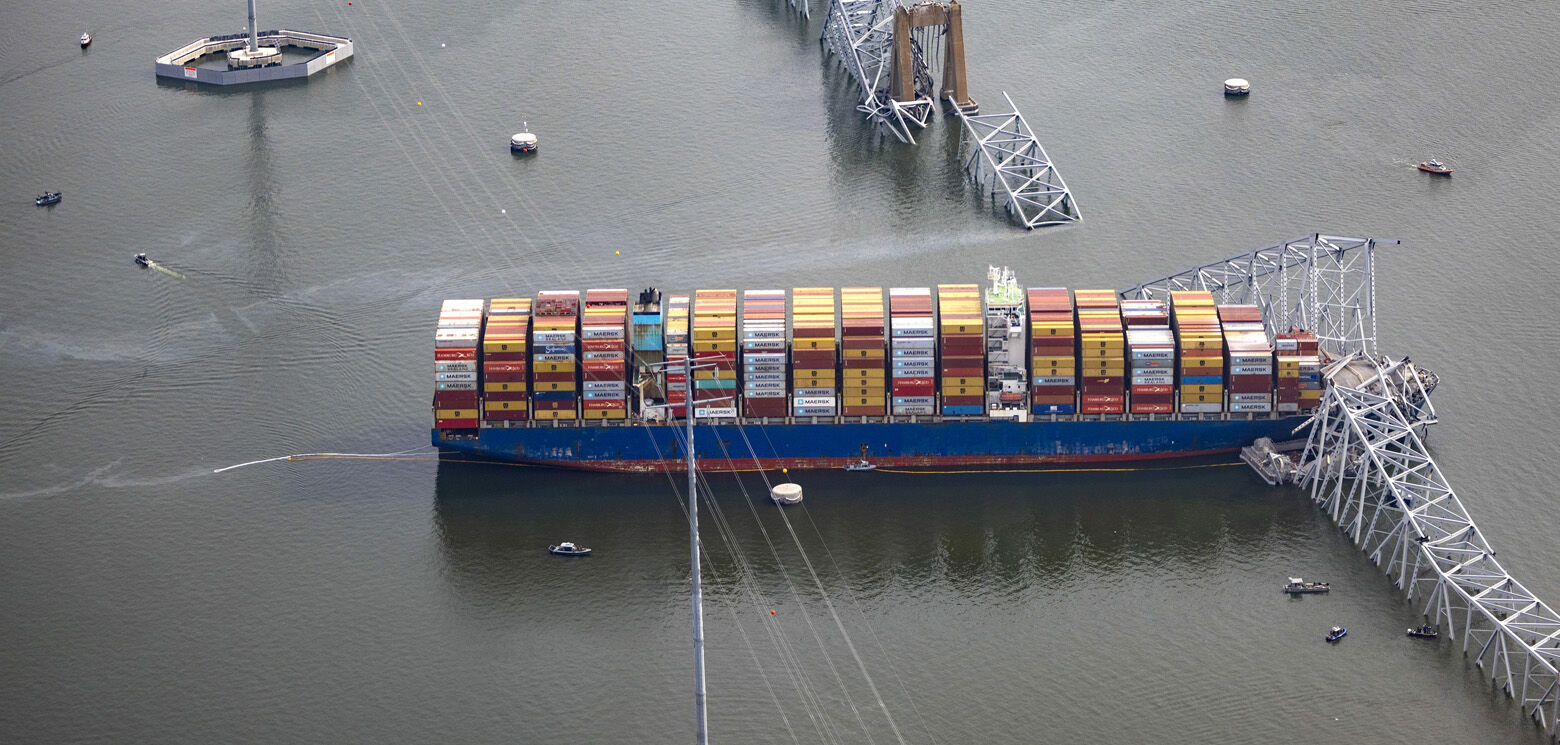
In the early morning hours of March 26, a huge container ship lost power and careened into Baltimore’s Francis Scott Key Bridge, causing most of the bridge to collapse into the Patapsco River.
Six construction workers were killed in the collapse. And the destruction and extensive recovery efforts raised concerns about the implications to international shipping and commerce — the Port of Baltimore is the ninth-busiest port in the nation.
See the latest coverage.
- Latest photos from the Patapsco: From Key Bridge collapse to recovery efforts
- WATCH: Live view of Key Bridge collapse cleanup
- Biden Administration asks for emergency funds for Key Bridge replacement
Owner, operator of ship that caused Baltimore bridge collapse to pay $100M in settlement with US
The owner and manager of the cargo ship that caused the Baltimore bridge collapse have agreed to pay more than $100 million to settle a lawsuit brought by the Justice Department.
The settlement comes a month after the Justice Department sued Dali owner Grace Ocean Private Ltd. and manager Synergy Marine Group, both of Singapore, seeking to recover more than $100 million that the government spent to clear the underwater debris and reopen the city’s port.
Baltimore longshoremen sue owner and manager of ship that caused the Key Bridge collapse
A group of Baltimore longshoremen have sued the owner and manager of the ship that caused the Francis Scott Key Bridge collapse, arguing the companies should compensate them for wages lost while the port was closed in the aftermath of the deadly disaster.
WATCH: Maryland files federal lawsuit against owners of Dali cargo ship that crashed into Key Bridge
Maryland filed a federal lawsuit against the company that owns the cargo ship that crashed into Baltimore’s Francis Scott Key Bridge in March.
State officials announced the lawsuit Tuesday, arguing that centuries-old maritime laws that limit liabilities do not apply to the Dali.
“We will recover the cost to rebuild our beloved bridge, the loss revenues from tolls and taxes and resources spent responding to Marylanders’ needs on that bridge on that tragic day and its aftermath,” Attorney General Anthony Brown said in a news conference.
No financial figure was specified in the lawsuit as the costs have not been calculated yet.
Brown said the owners of the ship knew, or should have known, that the Dali was not seaworthy and other safety measures were not followed.
The announcement comes after the families of three of the six immigrant construction workers who died in the bridge’s collapse said they would take legal action to hold Grace Ocean Private Limited legally liable.
The Justice Department also sued the Dali’s owners for causing the bridge’s collapse, seeking to recover more than $100 million the government spent clearing the underwater debris and reopening the city’s port.
Read more by The Associated Press here.
Watch the press conference below:
WTOP’s John Domen contributed to this report.
Road work inspector who leaped to safety during Baltimore bridge collapse to file claim
It was just another overnight shift for Damon Davis, a road construction inspector who was supervising repairs on Baltimore’s Francis Scott Key Bridge — until the deck beneath his feet started crumbling.
He ran for his life and, miraculously, made it to safety moments before the bridge collapsed into the water below.
“You can visualize, as he is coming forward, the bridge is collapsing behind him,” said Baltimore attorney Billy Murphy, whose firm is representing Davis in a liability case against the owner and manager of the Dali, the massive container ship that veered off course and crashed into one of the bridge’s supporting columns in March.
The attorneys held a news conference Thursday to announce their upcoming claim.
Justice Department sues over Baltimore bridge collapse and seeks $100M in cleanup costs
The U.S. Justice Department on Wednesday sued the owner and manager of the cargo ship that caused the Baltimore bridge collapse, seeking to recover more than $100 million that the government spent to clear the underwater debris and reopen the city’s port.
The lawsuit filed in Maryland alleges that the electrical and mechanical systems on the ship, the Dali, were improperly maintained, causing it to lose power and veer off course before striking a support column on the Francis Scott Key Bridge in March.
“This tragedy was entirely avoidable,” according to the lawsuit.
Wife of Baltimore bridge collapse victim says her ‘dreams were shattered’
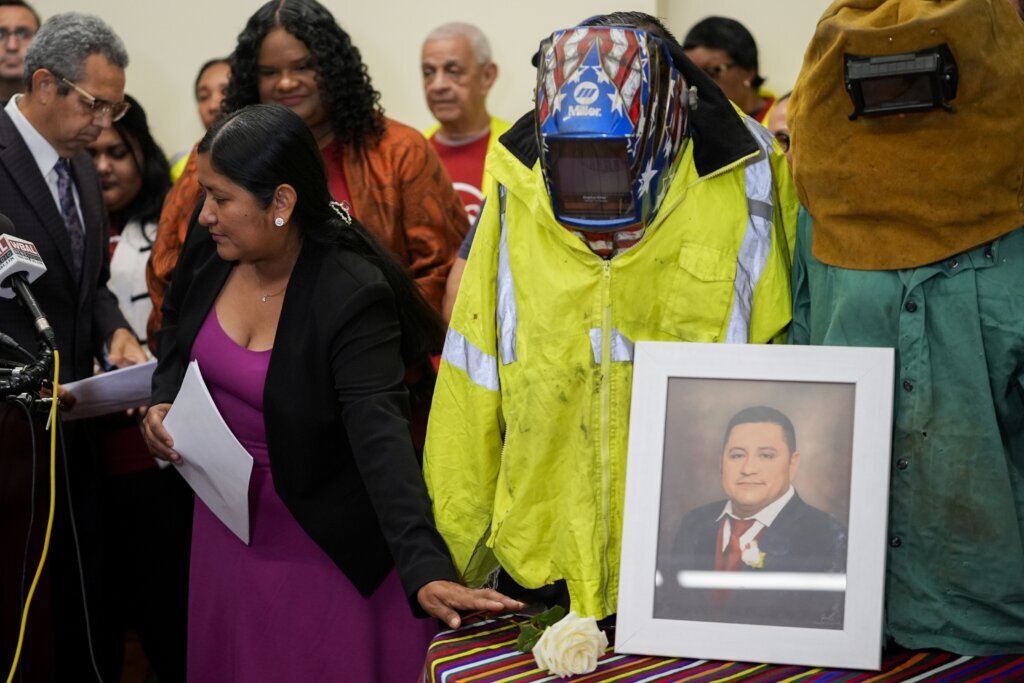
Maria del Carmen Castellón-Luna said the day of the Francis Scott Key Bridge collapse in Baltimore was the “hardest day of my life.”
Her husband, Miguel Luna, was one of six construction workers who died when a container ship crashed into the bridge in March, causing it to collapse into the Patapsco River.
Castellón-Luna spoke to reporters through a translator on Tuesday, as she and other loved ones of workers who died announced legal action in the case.
“That day, a wound was open in my heart that will never heal,” Castellón-Luna said, calling her late husband her “best friend” and her “companion.”
Key Bridge victims’ families to take legal against shipowner
The families of three of the six immigrant construction workers who died when the Francis Scott Key Bridge collapsed will be asking a federal court to prevent the owner of the ship that crashed into the structure from escaping legal liability.
The families announced on Tuesday they will take legal action to hold Grace Ocean Private Limited legally liable for the deadly collapse. The Singapore-based company owns the Dali, the massive container ship that rammed into the Francis Scott Key Bridge in late March after it lost power, causing a large section of the bridge to collapse.
If approved by the federal district court in Maryland, the move announced Tuesday could allow the victims’ families to request and obtain monetary compensation for the deaths of their loved ones, said Matthew Wessler of Gupta Wessler LLP, the firm planning to file the court motion.
Maryland awards contract for Francis Scott Key Bridge rebuild after deadly collapse
Maryland transportation leaders on Thursday approved a contract for rebuilding the Francis Scott Key Bridge several months after the 1.6-mile (2.6-kilometer) steel span collapsed under the impact of a massive container ship that lost power and crashed into one of its supporting columns.
In the immediate aftermath of the deadly March 26 collapse, officials quickly promised to rebuild the bridge — a longstanding Baltimore landmark and vital piece of transportation infrastructure.
They cited a 2028 completion date and estimated the project would cost $1.7 billion and would include significantly more pier protection to better defend against future wayward ships.
At a monthly meeting Thursday morning, the Maryland Transportation Authority board awarded a $73 million contract for the first phase of the project to Kiewit Infrastructure, which calls itself “one of North America’s largest and most respected engineering and construction organizations.”
Baltimore City police release body cam footage of sole survivor from Key Bridge collapse
Newly released body camera footage from the Baltimore City police shows the rescue of the sole survivor from the Francis Scott Key Bridge collapse in March.
Julio Cervantes Suarez can be seen trembling out of the frigid water and grasping on to railings as officials help him into an ambulance. He was still wearing his construction vest.
Six other construction workers were killed in the collapse.
The Port of Baltimore was reopened in mid-June following nearly 11 weeks of cleanup from the collapse, including the removal of the cargo ship Dali.
The Baltimore Banner was first to obtain a copy of the video via a Maryland Public Information Act request.
Maryland OKs $50.3M contract for removal of Key Bridge collapse debris
A Maryland board led by Gov. Wes Moore approved a $50.3 million emergency contract to pay a Swedish construction company that removed debris from the March collapse of the Francis Scott Key Bridge.
Attorneys for Baltimore reach deal that allows some Dali crew members to fly home, court filings say
After 12 weeks stuck aboard a cargo ship that lost power and crushed a famed Baltimore bridge, some of the vessel’s 21 crew members could soon return to their families halfway around the world.
Attorneys for the City of Baltimore and the owner and manager of the Dali cargo ship reached a deal late Wednesday that could allow eight of the crew members to fly home as early as Thursday, according to documents filed this week in Maryland’s US District Court.
The 20 Indians and one Sri Lankan on board have been stuck on the ship since March 26, when the mammoth vessel lost propulsion, veered off course and destroyed the Francis Scott Key Bridge, killing six construction workers.
Crew members haven’t been able to get off the ship for a variety of reasons. While none of the crew have been charged in connection with the disaster, investigations are underway to determine who might be responsible for the catastrophe. And Baltimore’s mayor has announced legal action, vowing to “hold the wrongdoers responsible.”
Attorneys for Baltimore seek to keep crew members from bridge collapse ship from returning home
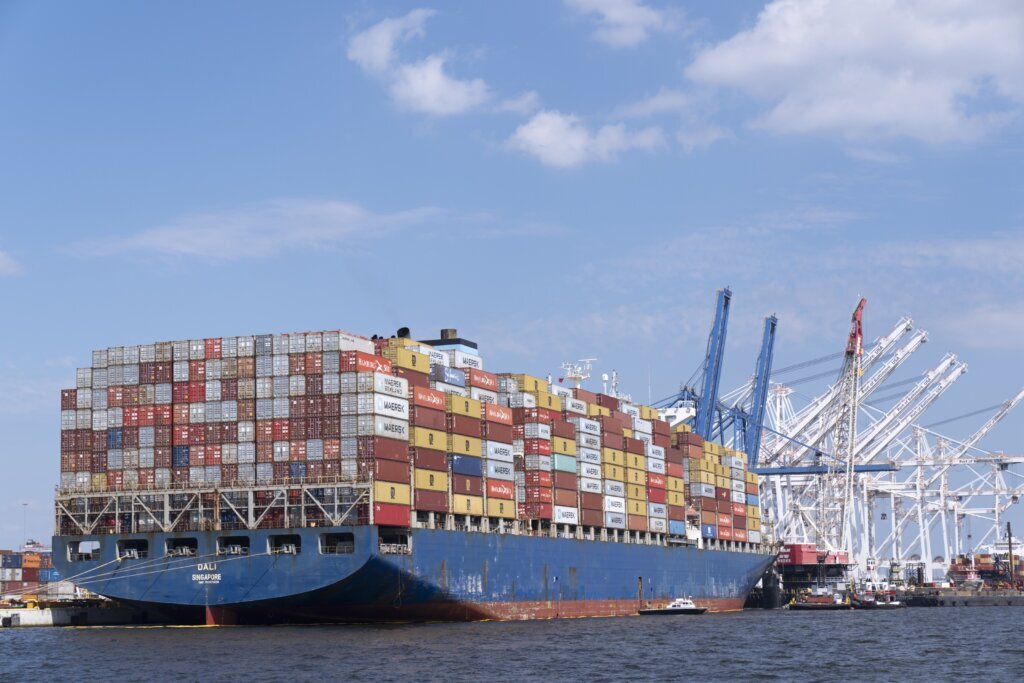
Attorneys are asking a federal judge to prevent crew members on the cargo ship Dali from returning to their home countries amid ongoing investigations into the circumstances leading up to the deadly collapse of the Francis Scott Key Bridge in March.
Eight of the Dali’s crew members were scheduled to debark the ship and return home as early as Thursday, according to emails included in court filings Tuesday. The roughly two dozen total seafarers hail from India and Sri Lanka.
That would mark the first time any of them can leave the ship since it lost power and crashed into one of the bridge’s supporting columns shortly after leaving Baltimore on March 26.
In the court filings, attorneys representing the City of Baltimore said the men should remain in the U.S. so they can be deposed in ongoing civil litigation over who should be held responsible for covering costs and damages resulting from the bridge collapse, which killed six construction workers and temporarily halted most maritime traffic through Baltimore’s busy port.
“The crew consists entirely of foreign nationals who, of course, have critical knowledge and information about the events giving rise to this litigation,” attorneys wrote. “If they are permitted to leave the United States, Claimants may never have the opportunity to question or depose them.”
Md. Gov. Moore: Programs for Key Bridge recovery will sunset in June
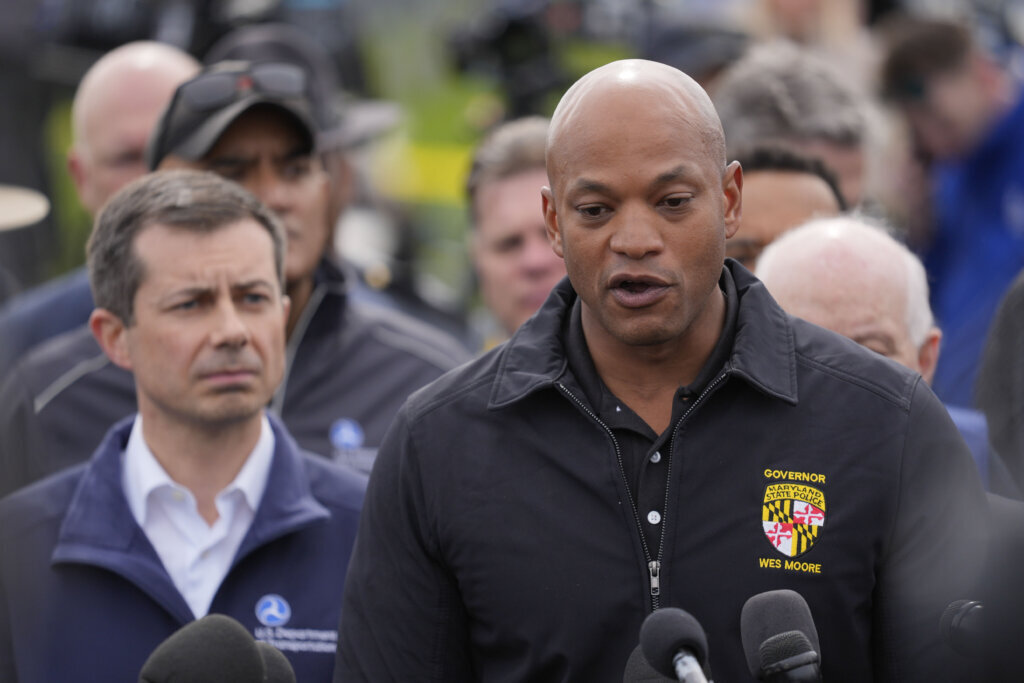
Maryland Gov. Wes Moore announced Friday that certain economic relief programs responding to the Francis Scott Key Bridge collapse will sunset, beginning in late June.
In a news release, the governor’s office said the programs, which began in April, have provided $37.4 million in assistance to those affected by the Francis Scott Key Bridge collapse on March 26.
Those include $6.4 million for minority or women owned businesses, and $22 million to support Baltimore area businesses, according to the release.
‘Reopened for business’: Maryland Gov. Wes Moore gives update on Port of Baltimore at Key Bridge collapse site
Maryland Gov. Wes Moore and other officials celebrated the reopening of the Port of Baltimore on Wednesday afternoon, 11 weeks after the Francis Scott Key Bridge collapsed, killing six construction workers and temporarily putting the port out of commission.
“The Fort McHenry channel is fully cleared and the Port of Baltimore is reopened for business,” Moore said during a news conference Wednesday afternoon at the reopened port.
The once eerily quite shipyard is now bustling after the shipping channel that allows access to the busy port was reopened earlier this week, officials said.
Moore paused his speech at the sound of a passing ship’s horn, “Hear that?” he asked the crowd.
“It’s a beautiful sound,” Moore said before continuing.
Maryland Transportation Secretary Paul Wiedefeld, Maryland Governor Wes Moore and U.S. Transportation Secretary Pete Buttigieg – symbolic of the state/federal efforts to clear the Baltimore shipping channel. @WTOP pic.twitter.com/9vG9MXZuDH
— Nick Iannelli (@NickWTOP) June 12, 2024
Moore applauded the work of federal, state and local government partners as well as private organizations who have contributed to recovery efforts.
“Today didn’t just happen, we made today happen” Moore said.
Officials have said they expect the bridge to be rebuilt by 2028. President Joe Biden has pledged the federal government will pay for building a new bridge.
“President Biden made clear from that first day and those early hours that the federal government would do everything that we could to support the city, the county, the state to get the Port of Baltimore back open and to get that bridge rebuilt,” U.S. Transportation Secretary Pete Buttigieg said. “And what followed was an embrace of the people of Baltimore by the whole administration and really by the whole country to get this port back open in less than 100 days.”
Shipping channel fully reopens two months after Key Bridge collapse
The channel that allows access to the Port of Baltimore has been fully cleared following nearly 11 weeks of cleanup from the Francis Scott Key Bridge collapse.
The full 700-foot-wide, 50-foot-deep Fort McHenry Channel was reopened June 10, according to the U.S. Army Corps of Engineers. Portions of the Maryland passageway have been shutdown since a cargo ship crashed into the bridge on March 26, killing six construction workers and throwing a wrench in the supply chain.
Fort McHenry Channel to be ‘fully restored in the next few days,’ District Commander for the Army Corps of Engineers says
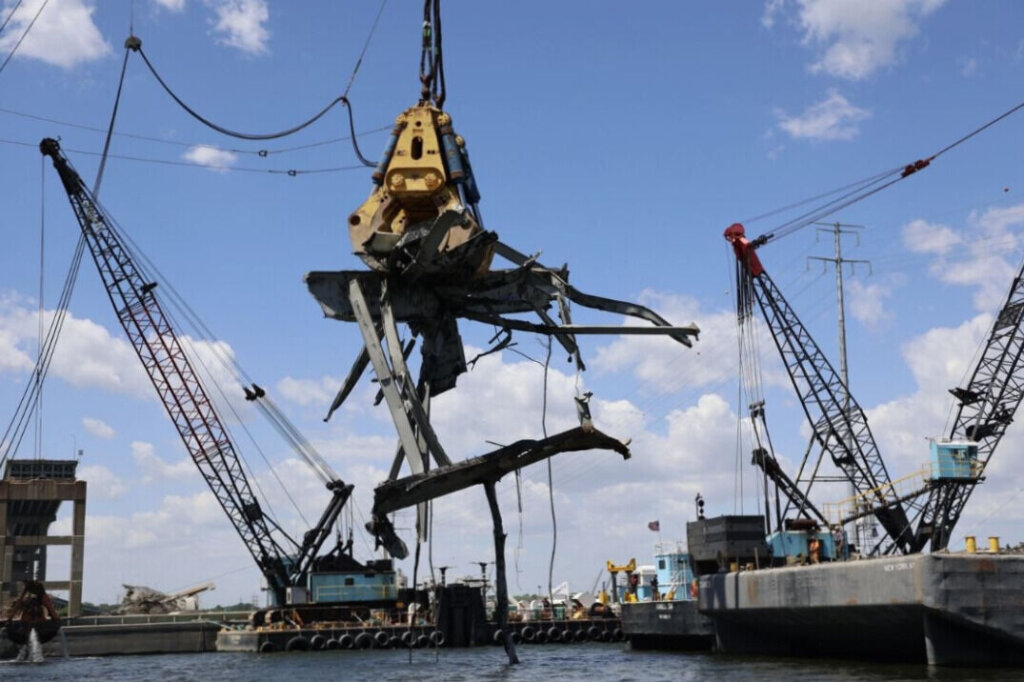
The Army Corps of Engineers said it expects the Fort McHenry Channel to be “fully restored in the next few days.”
That prediction came from Col. Estee Pinchasin, the Baltimore District Commander for the Army Corps of Engineers, in a statement issued Monday morning.
Pinchasin said once salvage crews clear the wreckage, “we will sweep the area with sonar, LIDAR and magnetometer, to investigate any high spots, ensuring there’s no hazard to navigation.”
The goal is to establish a 50-foot deep, 700-foot wide channel that provides access for all vessels in and out of the Port of Baltimore.
“We are going to be as thorough and disciplined as we have been since the beginning — we owe it to Baltimore and the Port, to turn over a safe navigation channel they can use with the greatest of confidence,” Pinchasin said.
Baltimore District Commander for the Army Corps of Engineers ‘fairly certain’ that Fort McHenry Channel will reopen on schedule
It’s been two months now since a huge container ship slammed into Baltimore’s Key Bridge causing most of it to collapse into the water and killing six construction workers. Crews continue to remove giant pieces of the Maryland bridge from the bottom of the Patapsco River with hopes of reopening the channel to all commercial ships by mid-June.
Workers have been using specialized cranes to pull out pieces of the bridge that weigh about 500 tons a piece since last Friday.
Col. Estee Pinchasin, the Baltimore District Commander for the Army Corps of Engineers, joined WTOP anchors Shawn Anderson and Anne Kramer live to discuss the latest on the cleanup efforts.
Listen to the full interview with Col. Estee Pinchasin here.
When will the full channel at the Key Bridge site open for boats?
The cleanup continues at the Francis Scott Key Bridge site continues and according to officials, the full channel used by ships coming in and out of the Port of Baltimore is expected to be cleared by mid-June.
A video release Tuesday by the Unified Command overseeing the Key bridge Response shows a Maryland State Police helicopter passing over the collapse site.
Gone is the nearly mile long view of twisted metal where the bridge once stood. Now, the video only shows one section of metal truss sticking out of the Patapsco River.
Officials are expecting to restore the Fort McHenry Federal Channel to its original 700-foot width and 50-foot depth by June 8-10, according to an update from the Key Bridge response Unified Command wrote in an update Tuesday.
Crews last week cleared a 400-foot-wide swath of the federal channel after they moved the container ship, the Dali. That channel permits all pre-collapse commercial ship travel to the Port of Baltimore.
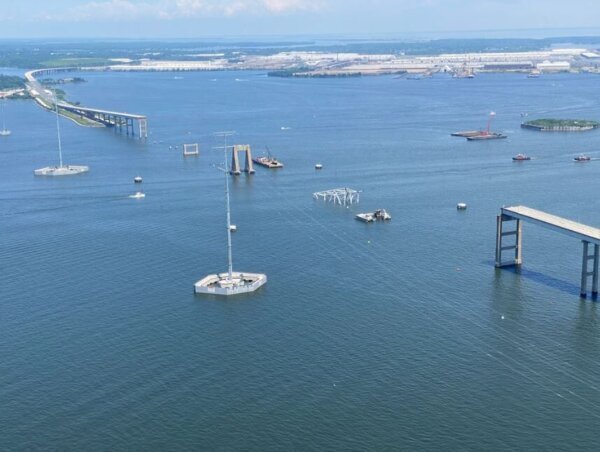
Organizers say Key Bridge Victims’ Memorial is getting too hard to maintain, last vigil to be held
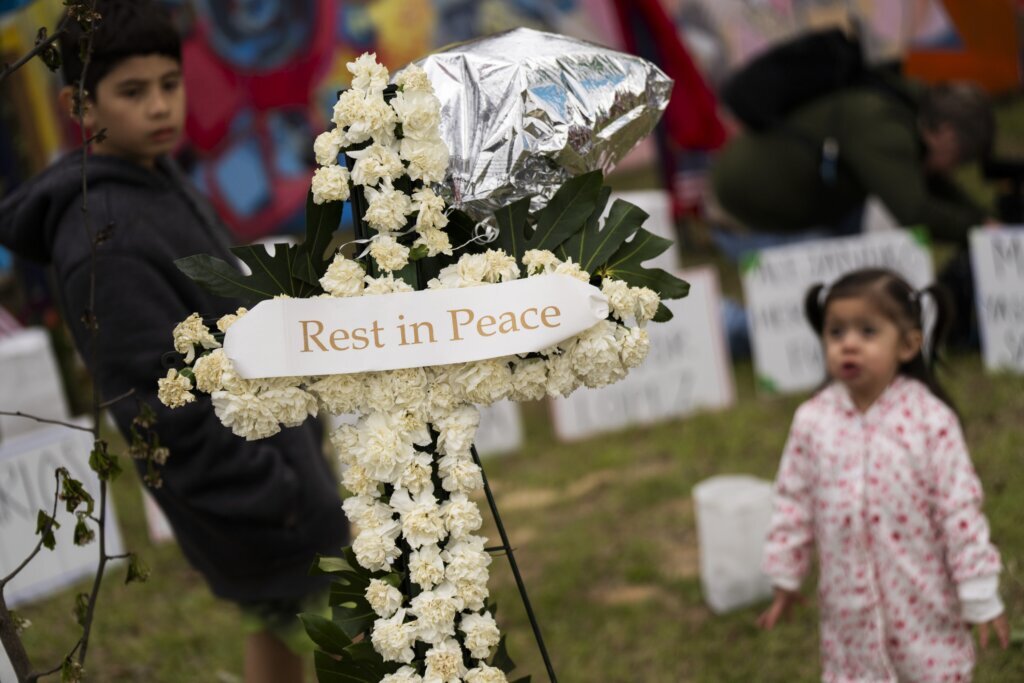
The last vigil at the Key Bridge Victims’ Memorial is set to be held this weekend.
Bernardo Vargas, who is one of the creators of the Ft. Armistead memorial in South Baltimore, told 11 News it’s hard to maintain the memorial site.
“I (want to) try to help my friends, my brothers,” Vargas said. “I don’t make no money, I don’t take money, (I do it) because I want to help.”
A whiteboard at the memorial site reads, “We tried to make this memorial permanent, but it couldn’t be done. We thank all the people who made this memorial possible for our Latin Brothers.”
Md. Gov. Moore lays out next steps at Baltimore Key Bridge collapse site after refloating Dali cargo ship
Maryland Gov. Wes Moore says while it is a pleasure not to see the container ship Dali near the site of where the Francis Scott Key Bridge collapsed, there is still much to do before Baltimore is back to normal.
In a press conference Tuesday, Moore said over the next week, about 20 vessels and barges are expected to come through the Port of Baltimore’s public terminal.
The Coast Guard plans to open a 400-foot wide, 50-foot deep channel that will operate 24 hours a day with the goal of opening the full 700-foot wide channel on the Patapsco River by the end of the month.
“Completion means coming together again to celebrate the reopening of the new Francis Scott Key Bridge,” Moore said.
See the press conference below.
Read more from The Associated Press.
WTOP’s Neal Augenstein contributed to this report.
WATCH: Tugboats escort ship that caused deadly Baltimore bridge collapse back to port
The recovery from the deadly Baltimore bridge collapse reached a significant milestone as the ill-fated container ship Dali was slowly escorted back to port, its damaged bow still covered with smashed shipping containers, fallen steel trusses and mangled concrete.
Refloated at high tide, the vessel slowly backed away from the site of the March 26 disaster, guided by several tugboats. The extensive damage to its bow included a massive, gaping hole above the waterline on its starboard side. Read the full story.
Watch the video below:
Unified Command to refloat, relocate Dali on Monday morning
High tide early on Monday morning will be the optimal time to refloat the Dali container ship in the Baltimore harbor, according to the Unified Command.
The salvage operation has taken nearly eight weeks. The preparations to refloat are to begin Sunday afternoon.
On Monday, the command plans to prepare the ship around 2 a.m. so that the vessel can “catch the peak high tide for a controlled transit.”
After it is refloated, the Dali with be berthed at a local marine terminal.
The plan is to release some of the anchors and lines attached to the Dali and the removal of the 1.25 million gallons of water that was pumped into the ship to compensate for the weight removed for precision cutting operations on May 13.
Once it’s free, the Unified Command said that up to five tugboats will escort the ship at roughly 1 mph on its 2.5-mile journey to the local terminal.
Maryland Gov. Wes Moore said Sunday he expects to have the channel reopened by the end of the month.
“I’m proud that we’re on track that by the end of May we’ll have that federal channel reopened,” Moore said on NBC’s Meet the Press. “And within days, we’re going to have that massive vessel, the Dali, out of that federal channel.”
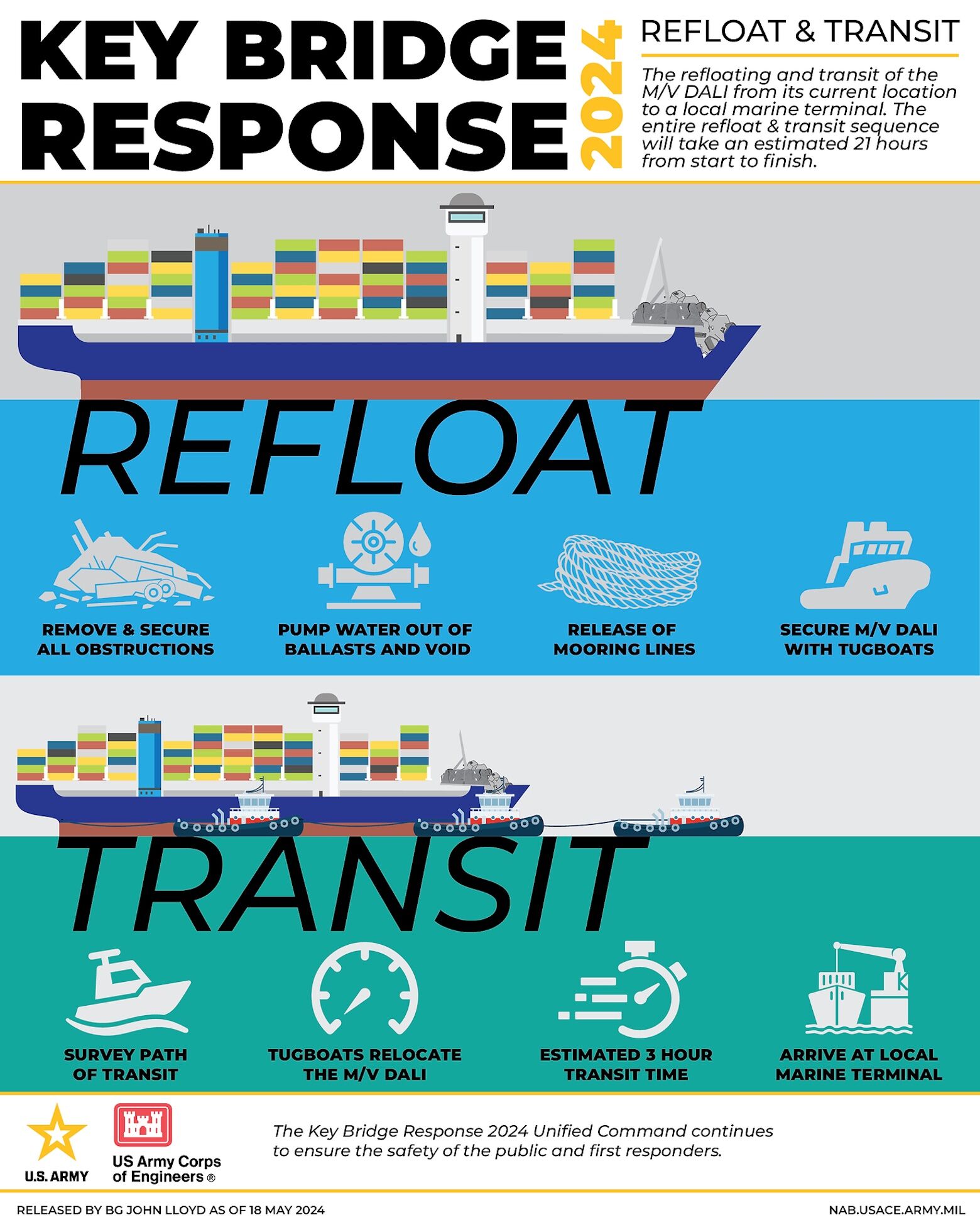
Crews prepare to refloat Dali container ship
Unified Command is continuing to evaluate the Dali cargo ship in preparation for refloating it and clearing the channel, officials said Thursday.
Officials from Unified Command said they’ve evaluated sonar and lidar imagery but are still waiting for results from a diver inspection before moving forward with refloating and ship moving plans.
The inspection is necessary, officials said, to mitigate any risk to the vessel when it’s moved.
The Fort McHenry Federal Channel is expected to be fully capable of supporting all commercial vessels in and out of the Port of Baltimore to a minimum operational depth of 50 feet in the coming weeks, according to officials.
The move comes several days after crews set off a chain of carefully placed explosives to breakdown the largest remaining span of the Francis Scott Key Bridge.
Cargo ship that caused Baltimore bridge collapse had power blackout hours before leaving port
Investigators probing the March collapse of the Francis Scott Key Bridge in Baltimore said in a preliminary report Tuesday the cargo ship Dali experienced an electrical blackout about 10 hours before leaving the Port of Baltimore while undergoing maintenance.
The power outage was caused by a crew member mistakenly closing an exhaust damper, causing the ship’s engine to stall, the report issued by the National Transportation Safety Board said. The ship lost power again and crashed into one of the bridge’s supporting columns shortly after leaving the port on March 26, which brought the bridge down in seconds.
A full investigation could take a year or more, the agency said.
Crews conduct controlled demolition on Baltimore bridge span as cleanup continues at collapse site
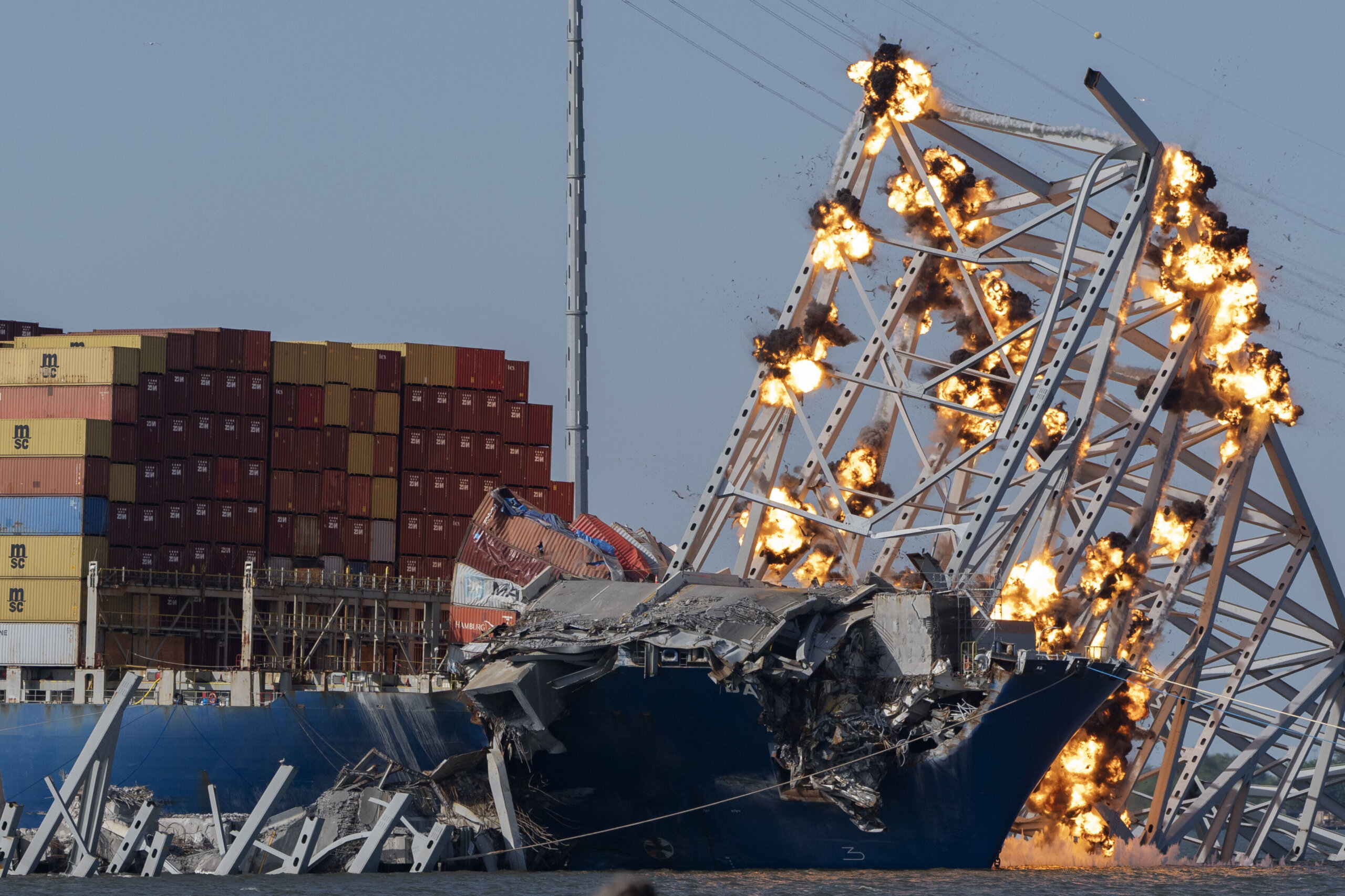
Crews conducted a controlled demolition Monday to breakdown the largest remaining span of the collapsed Francis Scott Key Bridge in Baltimore.
The explosives flashed orange and let off a cloud of black smoke upon detonation, and the span crumpled into the water in seconds. The longest trusses toppled away from the grounded Dali container ship and slid off its bow. Read the story.
Watch the video of the explosion below.
Newly-released body-worn camera footage reveals early response to Key Bridge collapse
Body camera video of the initial aftermath of the March 26 collapse of Baltimore’s Key Bridge has been released to the public, revealing some of the sights and sounds of one officer’s early response.
The video, obtained by ABC News through a Freedom of Information Act request, comprises nearly two hours of footage from the camera of a Maryland Department of Natural Resources Officer who arrived on the scene approximately an hour after the cargo ship Dali slammed into the bridge, bringing it down and killing six construction workers who had been on it.
Next phase of Baltimore Key Bridge cleanup: Small explosions to cut apart steel wreckage
The Key Bridge Response Unified Command is scheduled to use precision cuts made with small charges to remove a large section of the #FSKBridge wreckage from on top of the M/V DALI. pic.twitter.com/TQVfevF8Pz
— USACE Baltimore (@USACEBaltimore) May 8, 2024
Small explosive charges will be used to cut apart and remove a large section of the wreckage of Baltimore’s Francis Scott Key Bridge that’s draped across the front of the container ship Dali.
A U.S. Army Corps of Engineers video animation released by the Unified Command depicts how crews will use the “precision cutting” technique to cut apart the large steel truss that has remained across the bow of the Dali since the cargo ship crashed into the Baltimore bridge on March 26, causing much of the bridge to collapse into the Patapsco River.
6th and final victim of Baltimore bridge collapse recovered
Investigators have found and recovered the body of the sixth and final construction worker who plunged into the water when the Francis Scott Key Bridge collapsed in Baltimore last March.
The body of José Mynor López, of Baltimore was found Tuesday.
“With heavy hearts, today marks a significant milestone in our recovery efforts and providing closure to the loved ones of the six workers who lost their lives in this tragic event,” said Colonel Roland L. Butler Jr., Superintendent of the Maryland Department of State Police.
Officials said they have notified family members after Mynor López was positively identified.
“As we mourn with the families, we honor the memory of José Mynor López, Alejandro Hernandez Fuentes, Dorlian Ronial Castillo Cabrera, Maynor Yasir Suazo-Sandoval, Carlos Daniel Hernandez Estrella, and Miguel Angel Luna Gonzalez.”
This story is developing. Check back with WTOP for updates.
How close are crews to moving the ship that brought down the Key Bridge in Baltimore
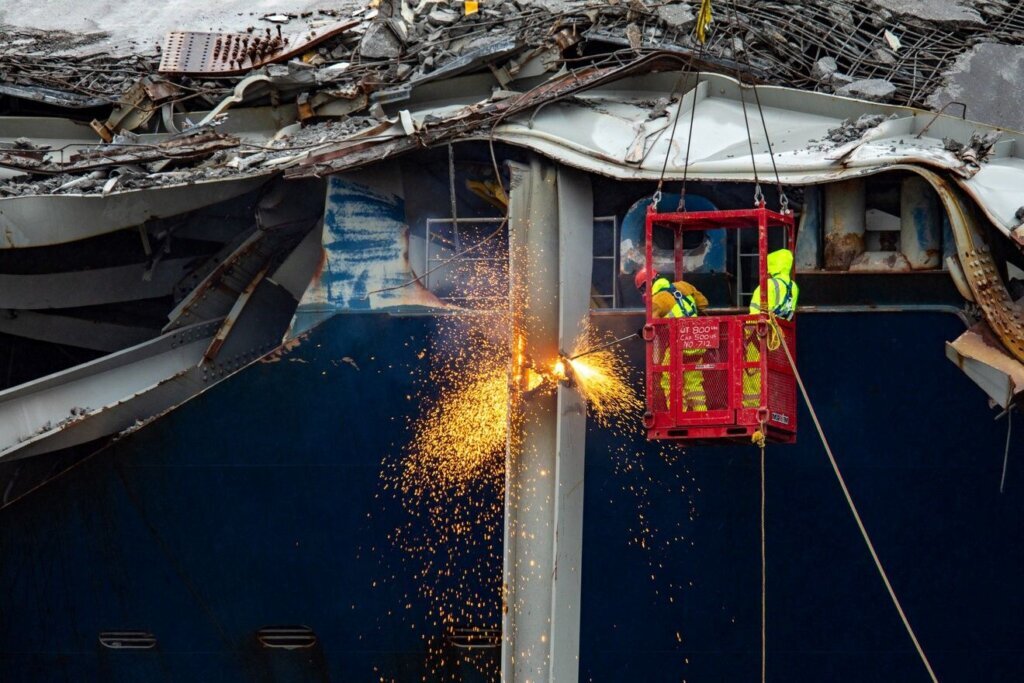
Debris and wreckage removal is ongoing in support of a top priority to safely and efficiently open the Fort McHenry Channel.
Salvage crews may be getting close to removing the collapsed portion of the Key Bridge in Baltimore that’s resting on that massive cargo ship.
Crews are in the process now of detailing what it will take to raise the section of the bridge that’s on top of the Dali, which caused the bridge to collapse in March after the collision.
Crews prep to remove debris from ship that collided with Baltimore Key Bridge
Salvage crews in Baltimore are getting ready to remove a chunk of the Key Bridge that collapsed on top of the container ship there.
“The operation requires careful handling of roadbed material, crushed containers, and bridge fragments currently resting on the M/V DALI’s bow,” officials said in an update.
Maryland officials release timeline, cost estimate, for rebuilding bridge
ANNAPOLIS, Md. (AP) — Maryland plans to rebuild the Francis Scott Key Bridge in just over four years at an estimated cost between $1.7 billion and $1.9 billion, a state transportation official said Thursday.
The state plans to build a new span by fall of 2028, said David Broughton, a spokesman for the Maryland Department of Transportation. He said the cost estimate is preliminary, and detailed engineering specifics have not been confirmed.
Meanwhile, the broker for the bridge’s insurance policy confirmed Thursday that a $350 million payout will be made to the state of Maryland in what is expected to be the first of many payouts related to the collapse.
5th Key Bridge collapse victim recovered, identified after vehicle located
Officials with the Unified Command team working on the Francis Scott Key Bridge in Baltimore, Maryland, have recovered and identified a fifth roadwork crew member who died in the collapse in March.
On Wednesday night, Unified Command announced 49-year-old Miguel Angel Luna Gonzalez, of Glen Burnie, was recovered when one of the missing worker trucks was found by salvage teams at the bridge.
Luna Gonzalez, a native of El Salvador, is one of the six roadwork crew members who died in the collapse of the bridge during the early hours of March 26.
Ship that brought down bridge to be removed from collapse site in the coming weeks
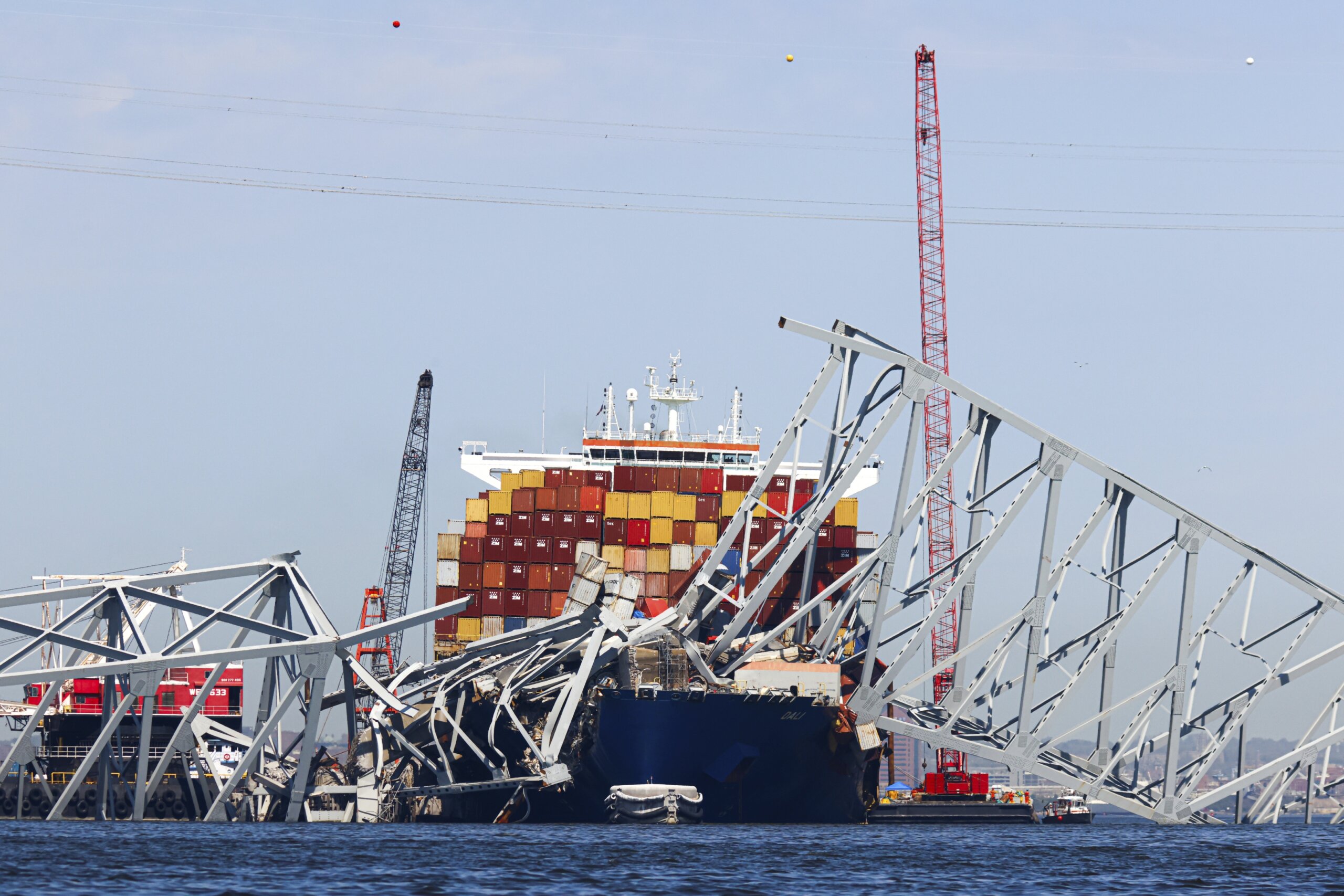
At the site of the Francis Scott Key Bridge collapse, crews plan to refloat and remove the grounded Dali container ship within roughly the next 10 days, allowing more maritime traffic to resume through Baltimore’s port.
The ship, which lost power and crashed into one of the bridge’s supporting columns, has been stationary amid the wreckage since the March 26 collapse. Officials expect to have it removed by May 10, according to a news release Tuesday from the Port of Baltimore.
First container ship arrives at Port of Baltimore since bridge collapse
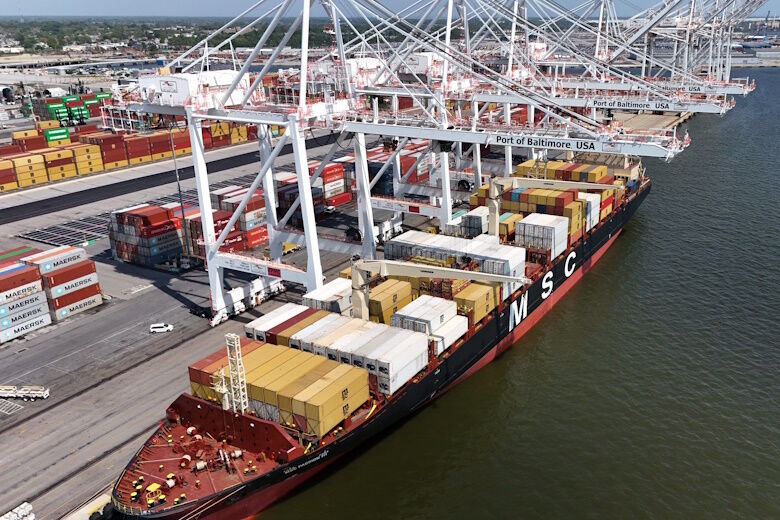
The first container ship arrived at the Port of Baltimore since the Francis Scott Key Bridge collapsed more than a month ago.
The MSC Cargo Passion III made it through the 35-foot temporary channel on Sunday carrying nearly 1,000 containers.
Baltimore port workers receive state aid, slowly get back to work
Things are slowly getting back to normal at the Port of Baltimore where thousands of workers are waiting for the shipping channel to fully reopen following the collapse of the Francis Scott Key Bridge a month ago.
Right now, the channel is only partially open.
“We’re doing a little bit better,” said Scott Cowan, president of the longshoremen’s union in Baltimore.
Cowan represents thousands who work at the port.
“It’s not what we’re looking for yet, but it’s a step in the right direction,” Cowan said, noting that it will be another month or so before the shipping channel is fully back to normal.
Even when that does happen, Cowan said it won’t be like flipping on a light switch.
“I’m sure it’s going to be a slow roll with cargo coming in because that stuff is booked weeks in advance,” said Cowan.
Longshoremen, truckers and small business owners have seen their jobs impacted by the collapse, prompting local and state officials to prioritize reopening the port and restoring its traffic to normal capacity in hopes of easing the economic ripple effects of the collapse.
First cargo ship passes through newly opened channel in Baltimore since bridge was struck, collapsed
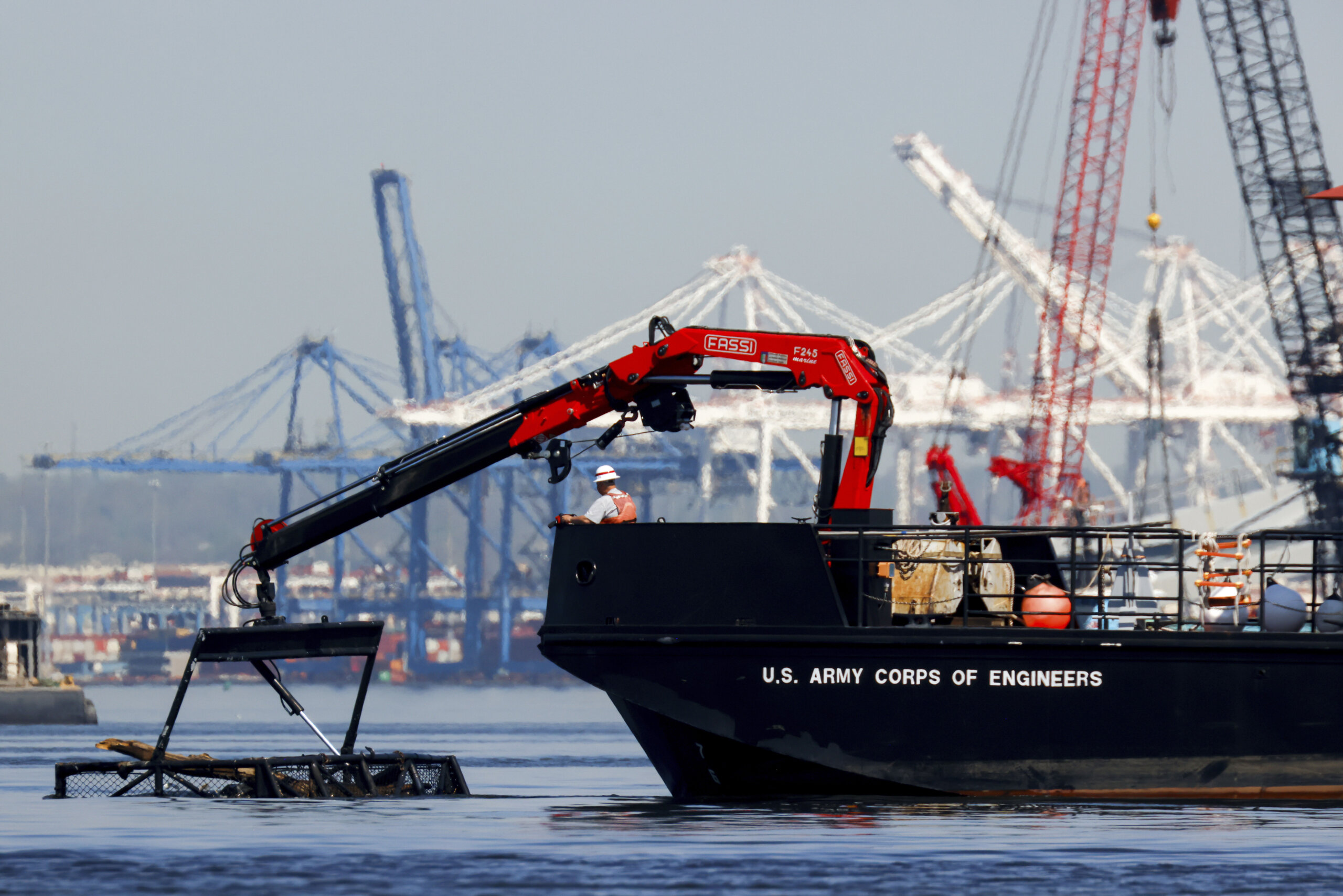
The first cargo ship passed through a newly opened deep-water channel in Baltimore on Thursday after being stuck in the harbor since the Francis Scott Key Bridge collapsed four weeks ago.
The ship is one of five stranded vessels expected to pass through the new, temporary channel.
Baltimore’s port administrator discusses response to Key Bridge collapse, impact — and what’s next
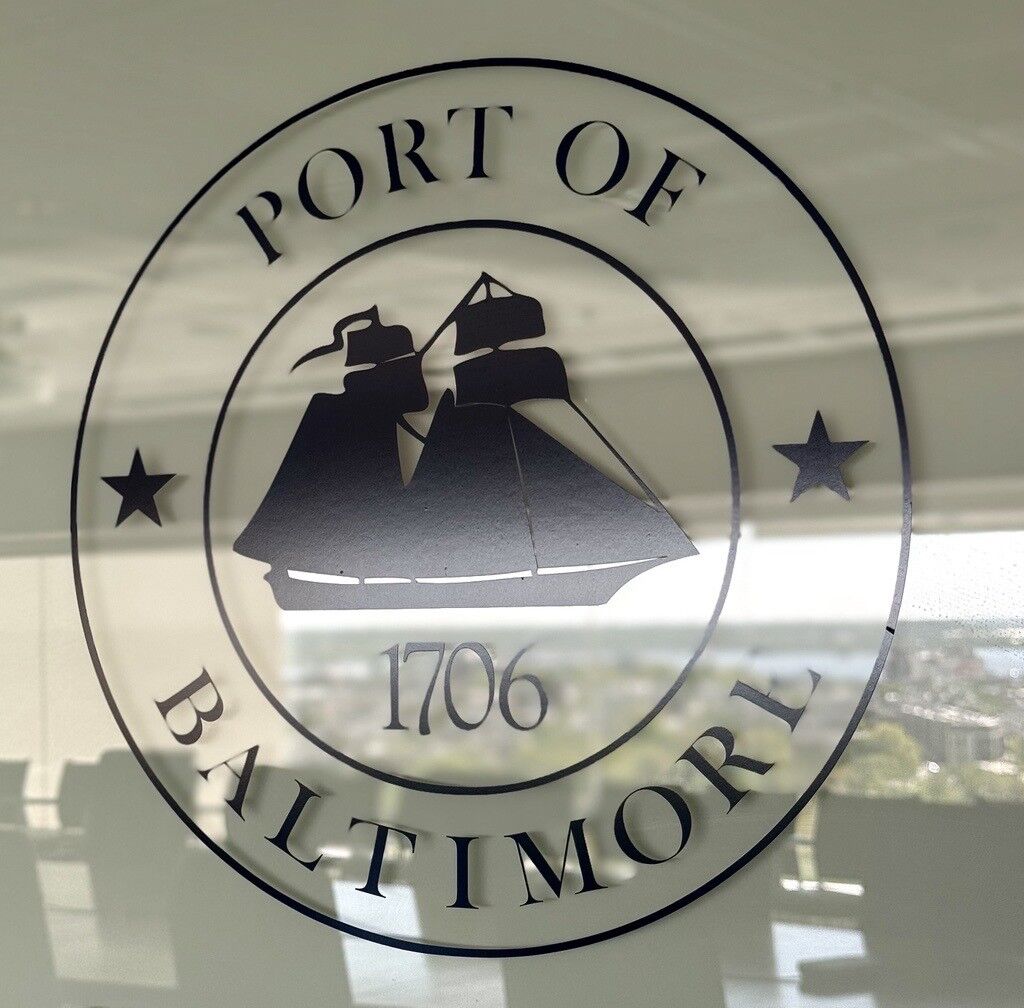
On Feb. 5, Jonathan Daniels assumed the role of executive director at the Maryland Port Administration.
Only seven weeks later, on March 26, Daniels found himself dealing with the tragic Francis Scott Key Bridge collapse, which claimed the lives of six construction workers and was “so catastrophic” that he said no one, including himself, could truly have been prepared.
Daniels sat down with WTOP to discuss what happened that day, what the response has been, and what kind of timeline and actions the Baltimore area — and entire nation — can expect to see in terms of rebounding from the devastating collapse.
Third temporary channel opens for vessels to Baltimore port after bridge collapse
A third temporary channel for boats to enter and depart the Port of Baltimore has opened, expanding further shipping access as collapsed sections of the Francis Scott Key Bridge are salvaged before the span can ultimately be rebuilt.
The alternate channel, located to the northeast of the fallen bridge, is open to “commercially essential vessels,” port officials announced late Friday.
How have drivers adjusted to the collapse of the Key Bridge? A look at the data
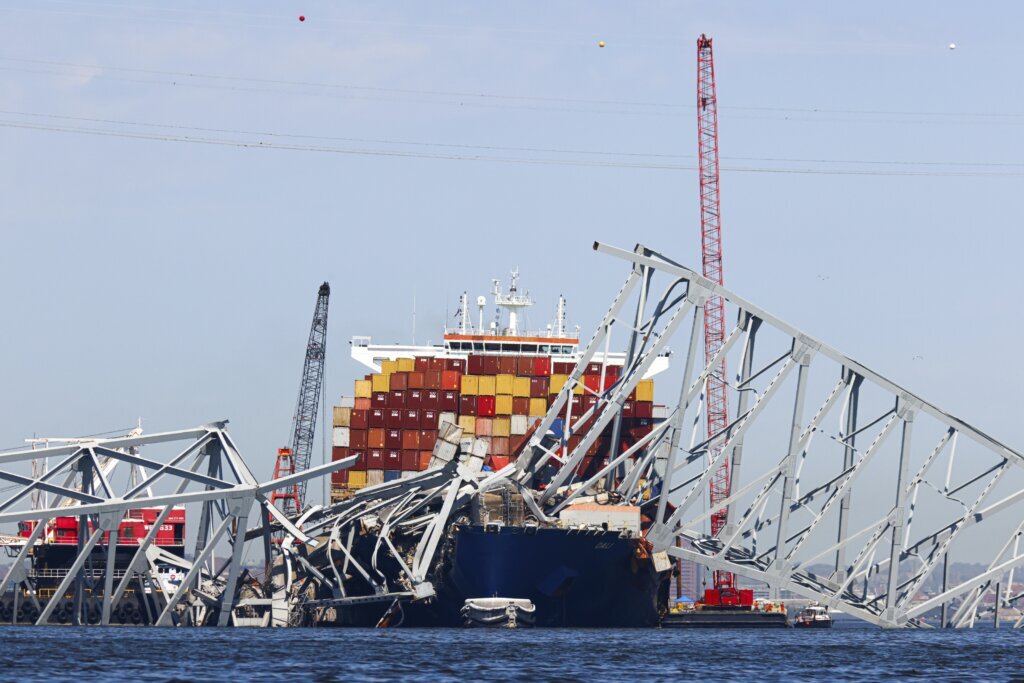
Baltimore’s Francis Scott Key Bridge used to carry more than 30,000 vehicles across the Patapsco River every day. Maryland’s Department of Transportation provided WTOP with an early look at how the drivers have adjusted.
The tunnels on Interstates 95 and 895 in Baltimore were already busier than the Key Bridge, and as you can expect, there’s even more traffic and longer delays to get through them now.
Since the bridge’s collapse, traffic along I-95’s Fort McHenry tunnel is up by about 11% since before the crash, according to a Maryland State Highway spokesman. Before the crash, the Fort McHenry tunnel saw more than 100,000 vehicles pass through it every day.
4th body recovered from Baltimore bridge collapse wreckage
The body of a fourth construction worker killed during the collapse of Baltimore’s Francis Scott Key Bridge was recovered Monday, the Key Bridge Unified Command announced in a news release.
The victim has been positively identified, but their identity is not being disclosed at this time at the request of the family.
Six construction workers were killed after the Dali container ship slammed into the bridge in the early morning hours of March 26. The crew was repairing potholes on the bridge and was on break at the time of the collapse.
Salvage teams located what they believed to be one of the missing construction vehicles and notified Maryland State Police. State troopers, the FBI and the Maryland Transportation Authority Police responded and found the victim trapped inside the vehicle, according to Unified Command.
“As we mourn the lives lost and continue the recovery operation, we recognize each missing individual is someone’s beloved friend or family member,” Col. Roland Butler Jr., superintendent of the Maryland Department of State Police, said in a news release. “Along with all of our allied law enforcement partners, we pledge to exhaust the physical and technical aspects of their training while deploying every available resource possible.”
FBI opens criminal investigation into Baltimore bridge collapse
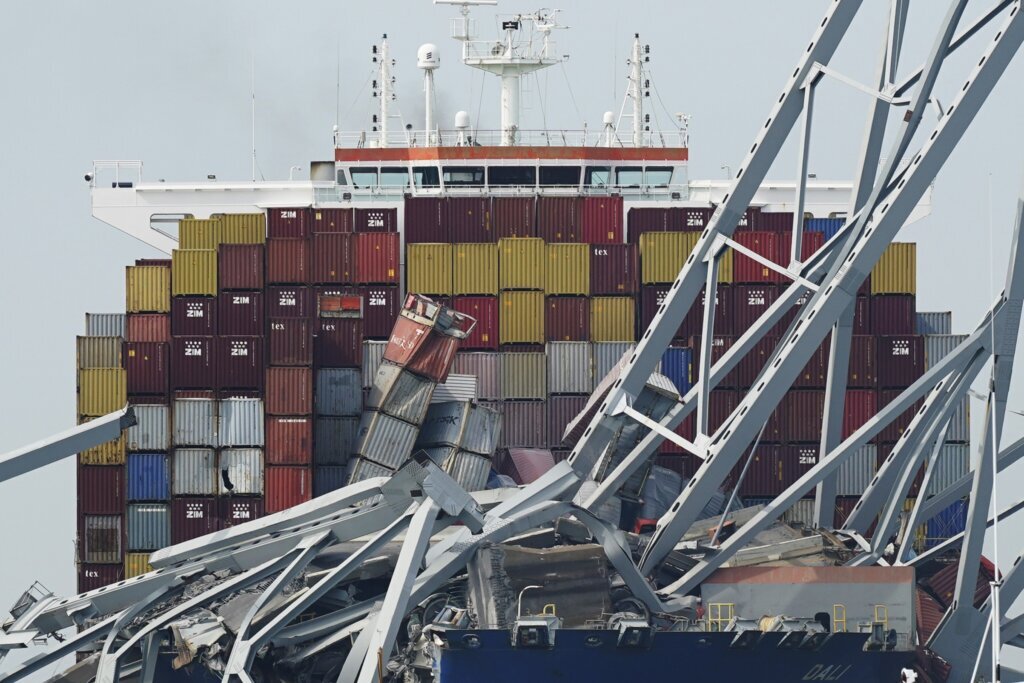
The FBI is conducting a criminal investigation into the deadly collapse of Baltimore’s Francis Scott Key Bridge that is focused on the circumstances leading up to it and whether all federal laws were followed, according to a person familiar with the matter.
The person was not authorized to discuss details of the investigation publicly and spoke on the condition of anonymity to The Associated Press.
The FBI was present aboard the cargo ship Dali conducting court authorized law enforcement activity, the agency said in a statement Monday.
Police divers at Baltimore bridge collapse struggle with ‘zero visibility’ underwater
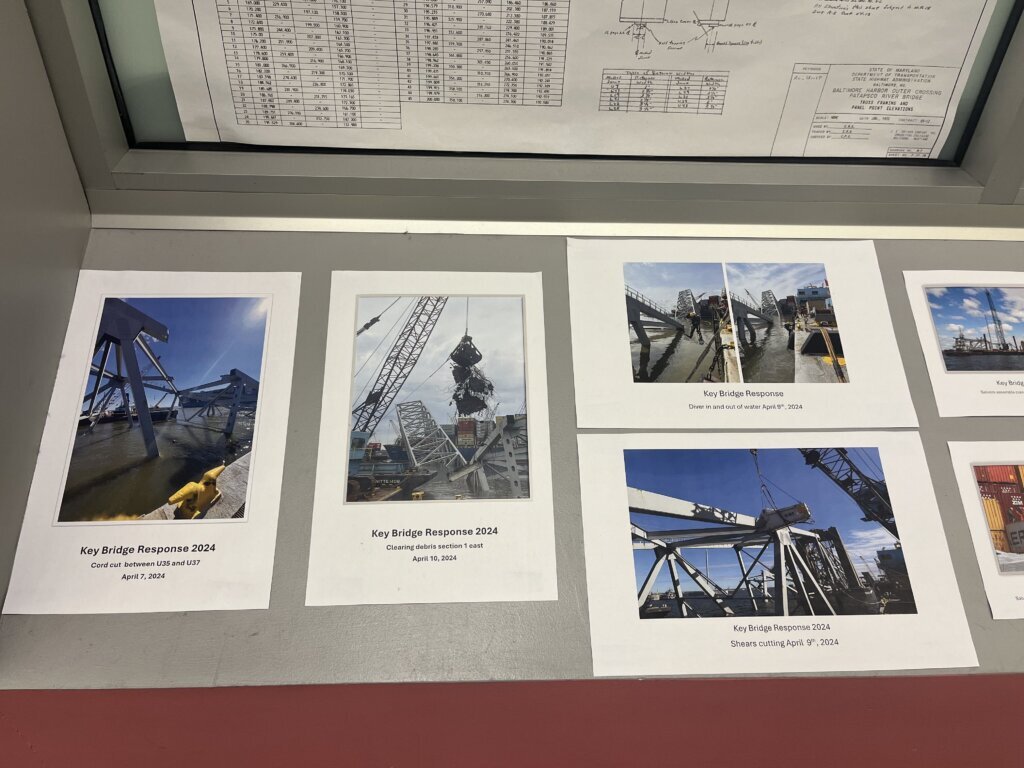
The mission is daunting at the site of the deadly collapse of the Francis Scott Key Bridge in Baltimore, Maryland, as crews have to remove 50,000 tons of debris.
Nonetheless, police divers are there, continuing an investigation into the collapse.
Visibility under the water is extremely poor, however.
“Best case scenario is you might be able to see eight inches in front of your face,” said Maryland State Police Cpl. Lyle German, who’s with the department’s underwater recovery team. “Worst case scenario, it’s like wearing one of those sleep masks, and you have zero visibility.”
‘It’s not a hope — it’s a plan’: Exclusive interview with Army Corps of Engineers official on front line of Baltimore Key Bridge recovery
Baltimore District Commander of the Army Corps of Engineers Col. Estee Pinchasin is on the front line of the operation to clear the wreckage of the Francis Scott Key Bridge and reopen more shipping channels so larger ships can make their way to the Port of Baltimore. She joined WTOP’s Shawn Anderson and Anne Kramer from Dundalk, Maryland.
New sonar images show striking detail of Key Bridge wreckage site
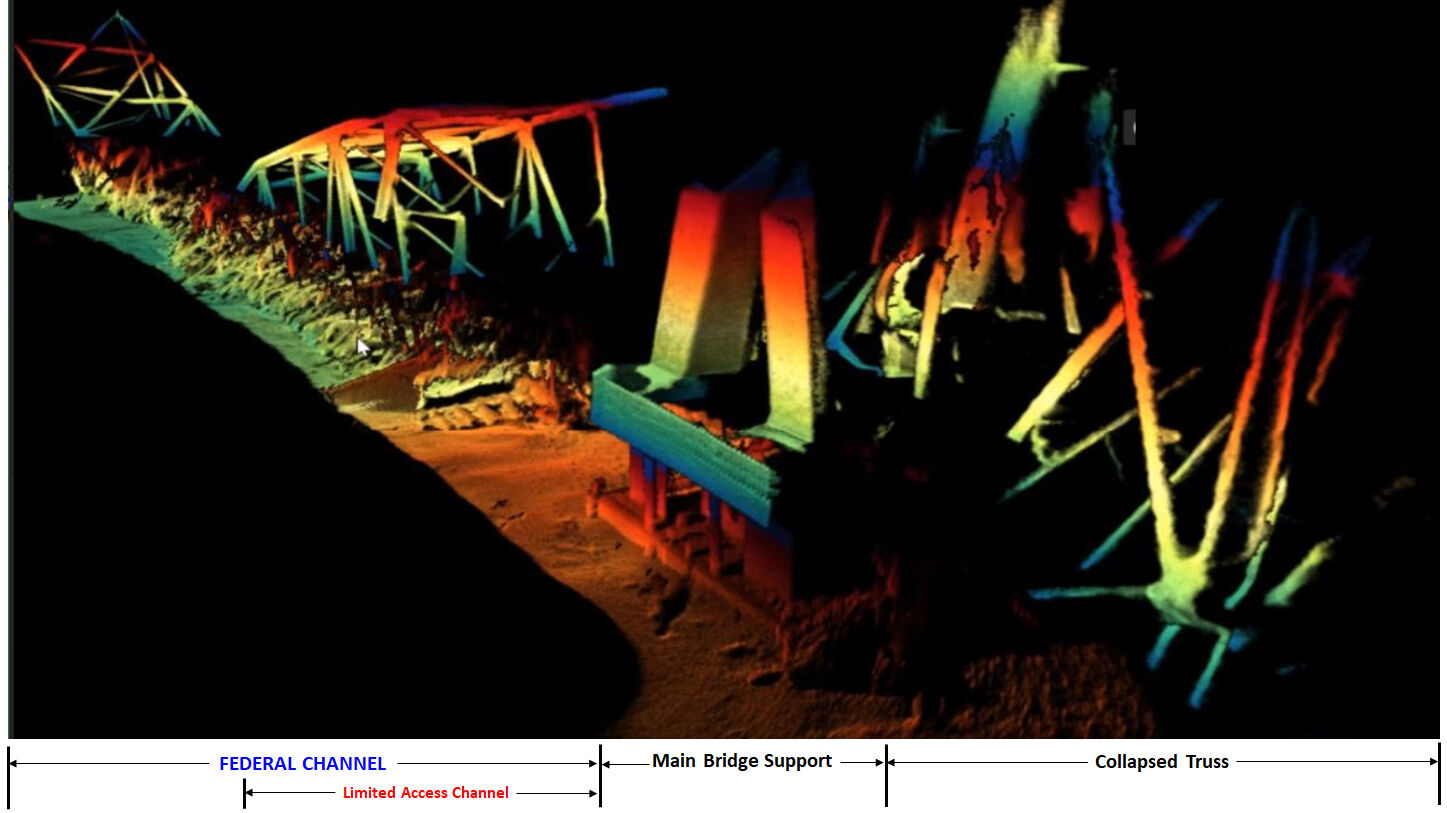
The U.S. Army Corps of Engineers revealed sonar images of the wreckage site, including the deepest part of the Port of Baltimore shipping channel.
Baltimore community honors workers killed in the Key Bridge collapse
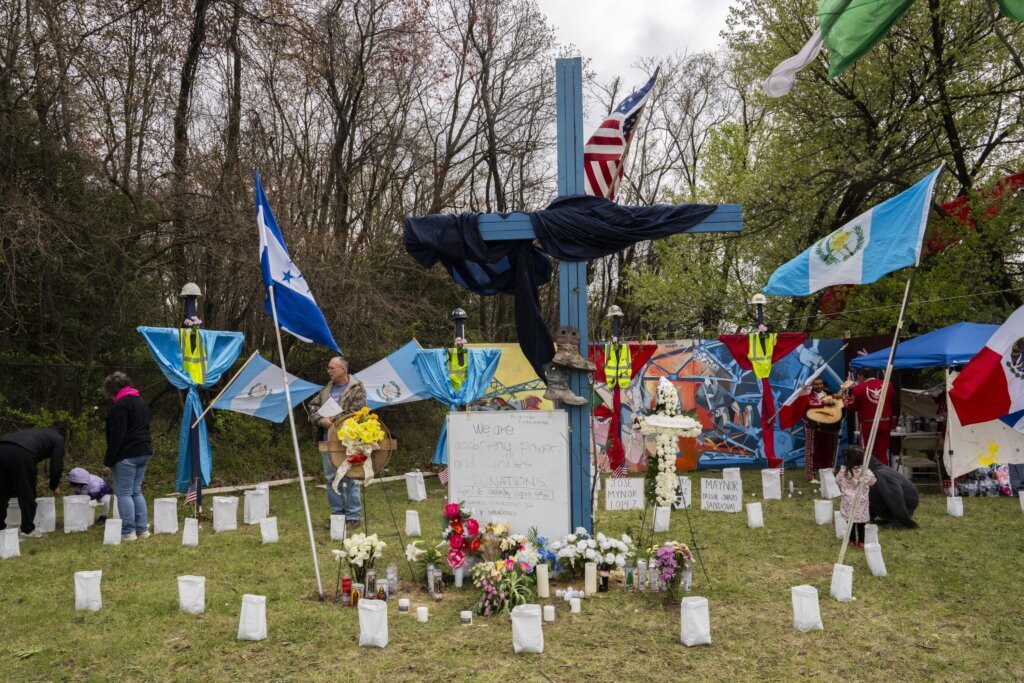
Local residents in Curtis Bay, Maryland, held a vigil on Saturday to honor the six people killed at the Francis Scott Key Bridge collapse.
A mural was built near Fort Armistead Road, the closest residents could get to the collapse site, local TV outlet WJZ reported. It features the names of the six construction workers, hard hats, work boots and the flags of their native countries. Members of the community honored the victims through prayer and song.
See more from the vigil below.
Salvage crews begin removing containers from ship that collapsed Key Bridge
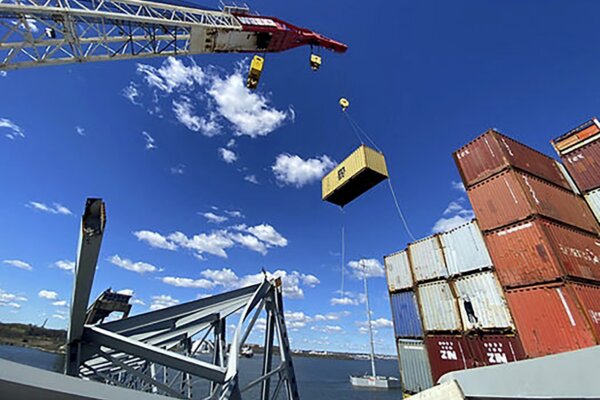
Salvage crews on Sunday began removing containers from the deck of the cargo ship that crashed into and collapsed the Francis Scott Key Bridge in Baltimore, an important step toward the full reopening of one of the nation’s main shipping lanes.
The removal of the containers from the deck of the Dali would continue this week as weather permits, according to a statement from the Key Bridge Response Unified Command. Crews were progressing toward removing sections of the bridge that lie across the ship’s bow to eventually allow it to move, the statement said.
3rd construction worker’s body found, ID’d
The body of another construction worker was pulled from the water Friday following the Baltimore Key Bridge collapse.
In a release from the recovery effort, officials said they found the remains of 38-year-old Maynor Yasir Suazo-Sandoval. His body was found around 10:30 a.m.
“Unified Command salvage dive teams located what they believed to be the missing construction worker and notified the Maryland Department of State Police. Maryland State Police Underwater Recovery Team deployed in coordination with dive teams from allied law enforcement partners and recovered Suazo-Sandoval,” authorities said.
“The collapse of the Key Bridge is undoubtedly one of the most challenging tragedies we have faced as a law enforcement agency. Along with our local, state and federal public safety partners, we will not give up,” Col. Roland L. Butler, Jr., Superintendent of the Maryland Department of State Police, said.
“There are families still waiting to hear if we have found their loved one. I can promise you, we are fully committed to finding closure for each of these families.”
Three more bodies have yet to be recovered.
Baltimore Orioles, Ravens donate $10M to bridge collapse recovery effort
The Baltimore Orioles and Baltimore Ravens have together donated $10 million to the Baltimore Community Foundation’s Key Bridge Emergency Fund.
The fund was established to provide ongoing support to the recovery and resilience efforts for families, port workers, first responders, small businesses and communities affected by the collapse of the Baltimore’s Francis Scott Key Bridge on March 26, the Baltimore Community Foundation said in a news release.
“The resiliency of our city has once again been sorely tested,” Orioles owner David Rubenstein said in the release. “Under the leadership of Gov. Wes Moore, and in collaboration with the Ravens, the Orioles offer this contribution to support those who keep our city, our state, and our country in business.”
For information on how to donate to the fund, visit the Baltimore Community Foundation’s website.
Biden tours collapsed Baltimore bridge as clearing proceeds and declares ‘your nation has your back’
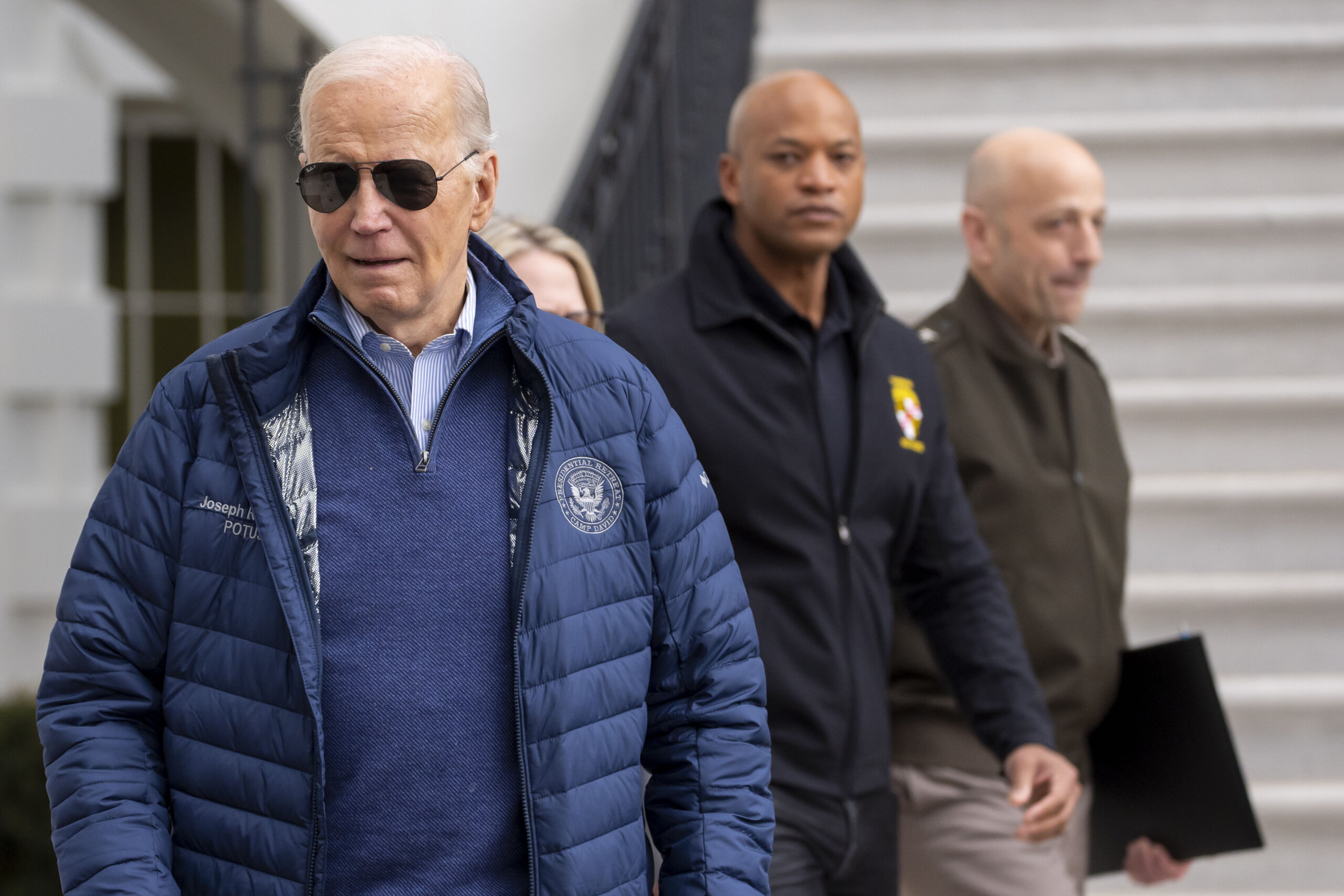
President Joe Biden got a firsthand look Friday at efforts to clear away the “mangled mess” of remains of the collapsed Francis Scott Key Bridge in Baltimore, as cranes, ships and diving crews work to reopen one of the nation’s main shipping lanes.
Aboard Marine One, circling the warped metal remains and the mass of construction and salvage equipment trying to clear the wreckage of last week’s collapse, Biden got his first up close view of the devastation. On the ground, he received a briefing from local officials, the U.S. Coast Guard and Army Corps of Engineers on the situation in the water and its impacts on the region.
Biden also greeted police officers who helped block traffic to the bridge in the moments before it was hit by the ship, which helped avert an even larger loss of life.
“I’m here to say your nation has your back and I mean it,” Biden said from the shoreline overlooking the collapsed bridge. “Your nation has your back.”
Tentative plan to restore navigation through Port of Baltimore
Engineers working to clear the wreckage of the collapsed Francis Scott Key Bridge in Baltimore announced they expect to be able to restore navigation in and out of the Port of Baltimore by the end of this month.
The bridge collapsed within seconds on March 26 after being struck by the cargo ship Dali, which lost power shortly after leaving Baltimore, bound for Sri Lanka. The ship issued a mayday alert with just enough time for police to stop traffic, but not enough to save a roadwork crew filling potholes on the bridge. Authorities believe six workers plunged to their deaths in the Patapsco River; two bodies have been recovered so far. Two others survived.
The U.S. Army Corps of Engineers announced a “tentative timeline” Thursday, saying in a news release that it expects to open a limited access channel to the port within the next four weeks measuring some 280 feet wide by 35 feet deep (85 meters by 11 meters). The channel would support one-way traffic in and out of the port for barge container service and some vessels that move automobiles and farm equipment to and from the port.
Baltimore bridge cleanup continues
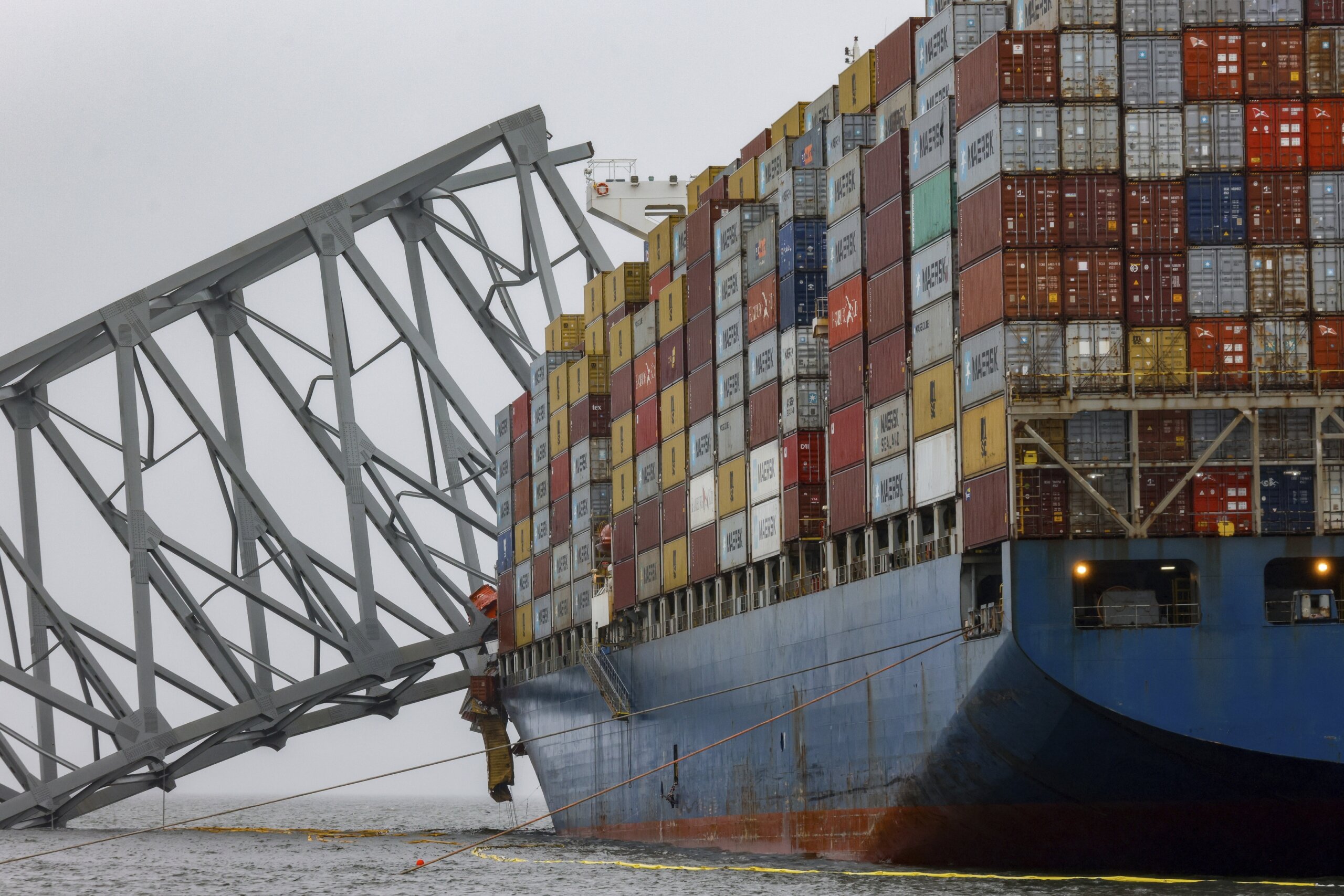
Crews continued clearing the mangled wreckage of the collapsed Francis Scott Key Bridge.
Crews opened a second temporary channel through the collapse site Tuesday, but it’s too shallow for most commercial vessels. The two alternate channels are meant primarily to aid in the cleanup effort. Work continues to open a third channel that will allow larger vessels to pass through the bottleneck and restore more commercial activity, officials said.
Meanwhile, bad weather has hindered salvage operations in recent days. The Patapsco River is also very murky, severely limiting the visibility of divers.
The sheer volume of debris dwarfed even the cranes and barges involved in the cleanup. And that’s only the view from above; officials said underwater conditions are significantly more challenging.
Divers are still trying to get a sense of the tangled, muddy web. Sonar is being used to map the wreckage on the river bottom in 50 feet (15 meters) of water. A large floating crane nicknamed “Chessy” is helping with the salvage.
Crews will soon begin lifting undamaged containers off the ship before removing the chunks of steel and concrete embedded in its bow, U.S. Coast Guard Rear Admiral Shannon Gilreath said at a news conference.
Second channel opened allowing some vessels to bypass wreckage at the Baltimore bridge collapse site
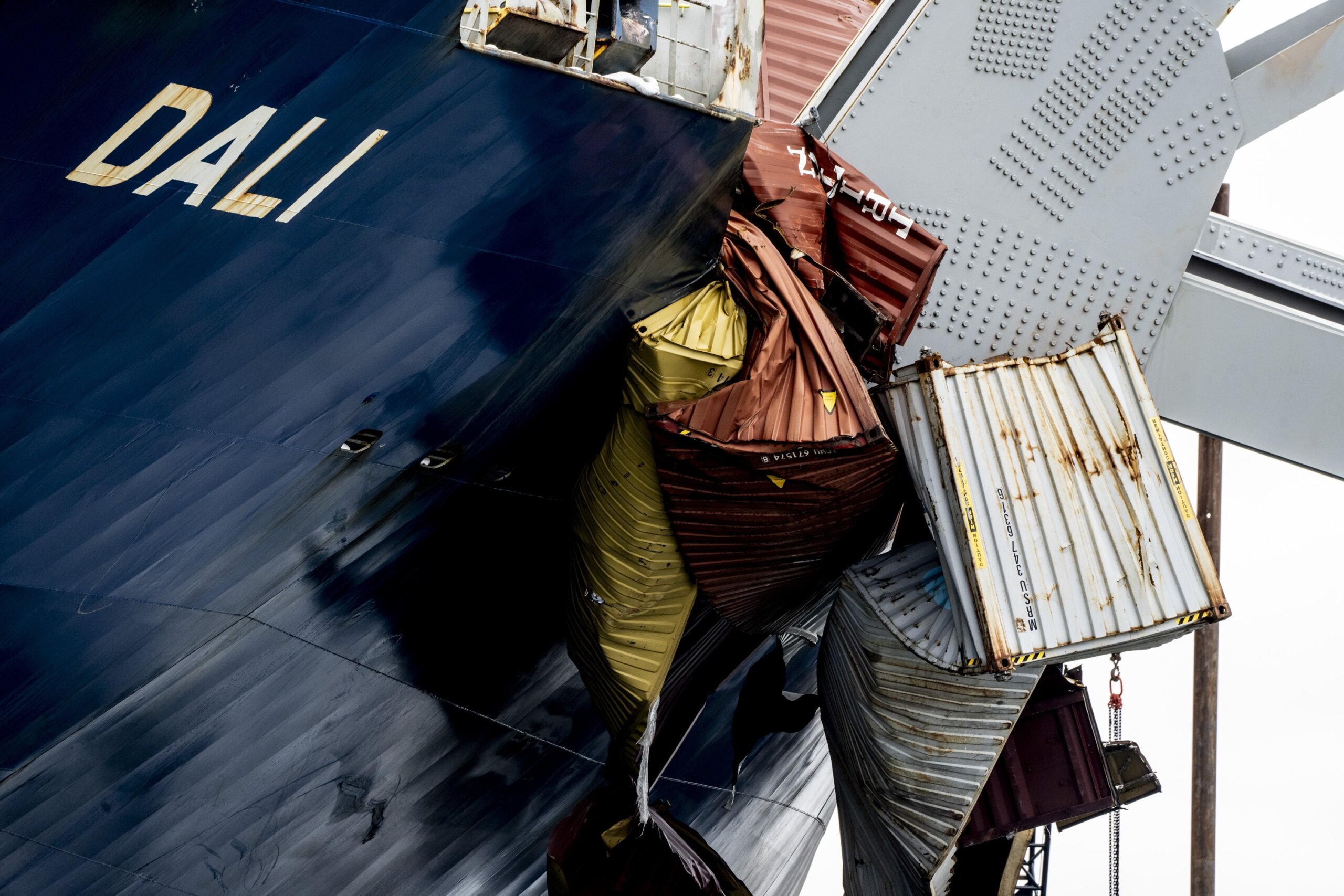
Crews opened a second temporary channel on Tuesday allowing a limited amount of marine traffic to bypass the mangled wreckage of Baltimore’s collapsed Francis Scott Key Bridge, which had blocked the vital port’s main shipping channel since its destruction one week ago.
Work is ongoing to open a third channel that will allow larger vessels to pass through the bottleneck and restore more commercial activity, officials announced at a news conference Tuesday afternoon. The channels are open primarily to vessels involved in the cleanup effort, along with some barges and tugs that have been stuck in the Port of Baltimore.
A tugboat pushing a fuel barge was the first vessel to use an alternate channel late Monday. It was supplying jet fuel to Delaware’s Dover Air Force Base.
Gov. Wes Moore said rough weather over the past two days has made the challenging salvage effort even more daunting. Conditions have been unsafe for divers trying to recover the bodies of the four construction workers believed trapped underwater in the wreckage.
Gov. Wes Moore discusses the recovery effort on WTOP
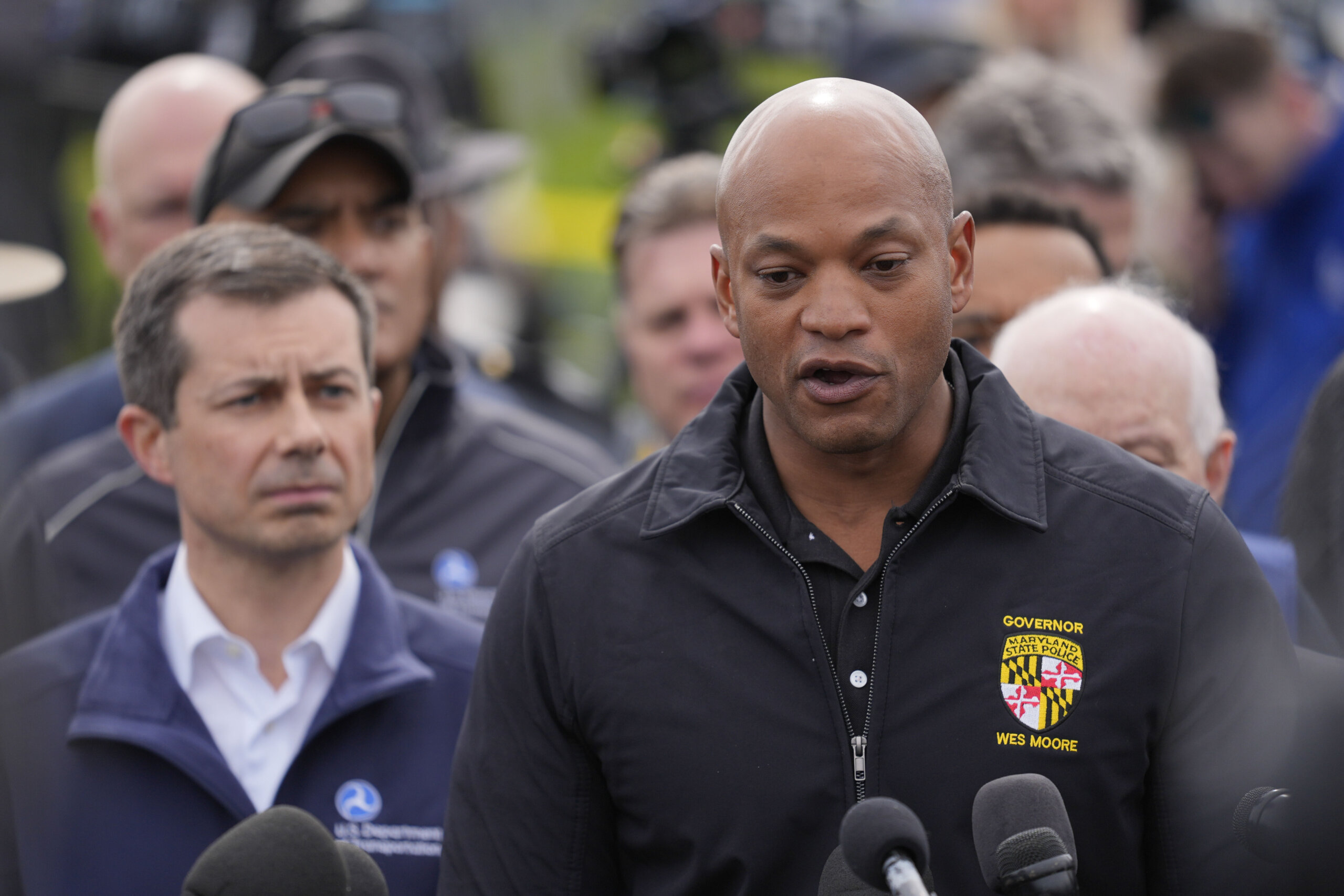
Maryland Gov. Wes Moore joined WTOP live from Dundalk, Maryland, to discuss the recovery efforts, saying the state was still in mourning a week after the collapse and revealing the key moments the night of the container ship crash that saved “countless lives.”
Channel opens for vessels clearing wreckage at Baltimore bridge collapse site
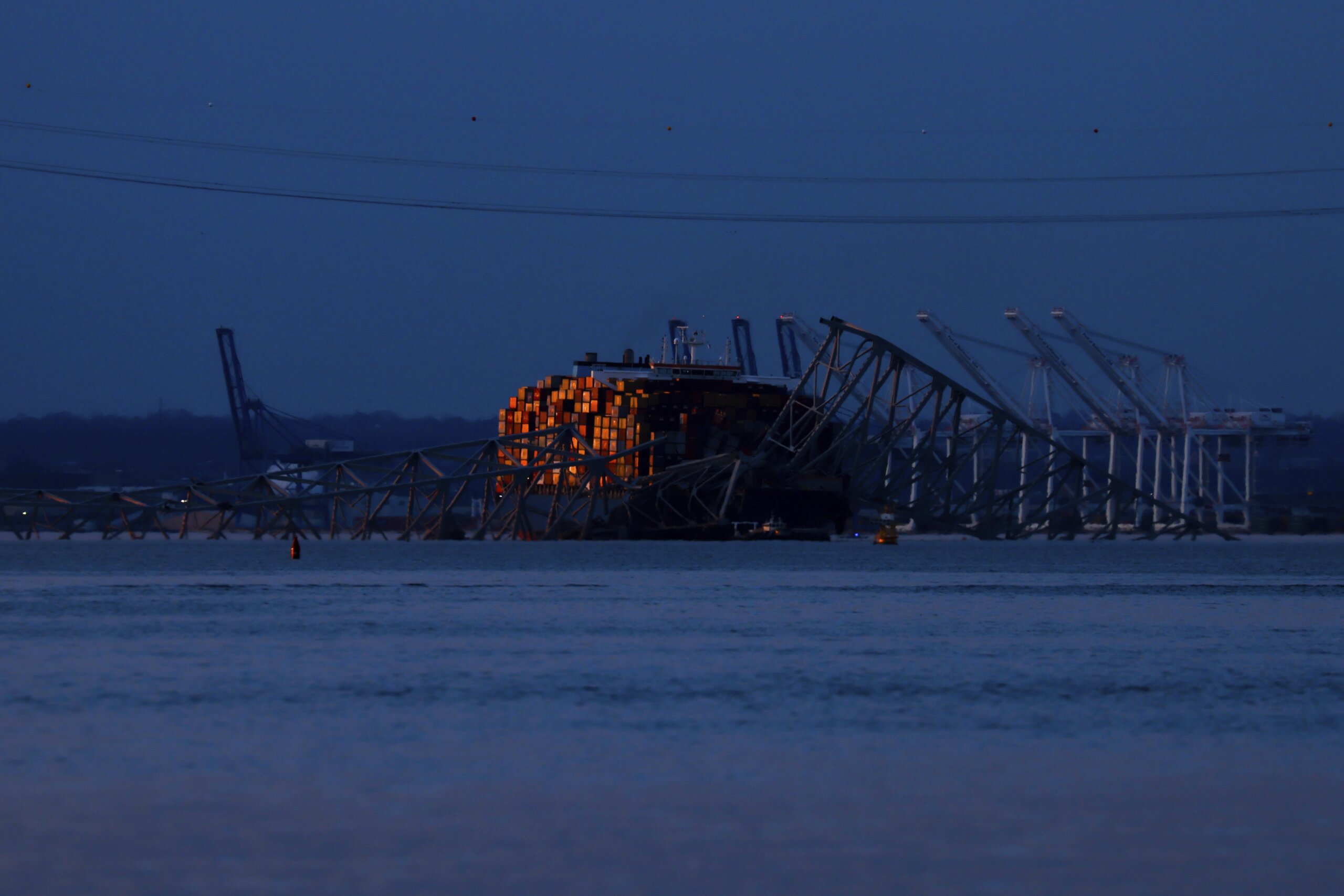
The U.S. Coast Guard has opened a temporary, alternate channel for vessels involved in clearing debris from the collapsed Francis Scott Key Bridge in Baltimore, part of a phased approach to opening the main shipping channel leading to the vital port, officials said Monday.
Crews are undertaking the complicated work of removing steel and concrete at the site of the bridge’s deadly collapse after a container ship lost power and crashed into a supporting column. On Sunday, dive teams surveyed parts of the bridge and checked the ship, and workers in lifts used torches to cut above-water parts of the twisted steel superstructure.
Officials said the temporary channel is open primarily to vessels that are helping with the cleanup effort. Some barges and tugs that have been stuck in the Port of Baltimore since the collapse are also scheduled to pass through the channel.
Small business recovery center opens
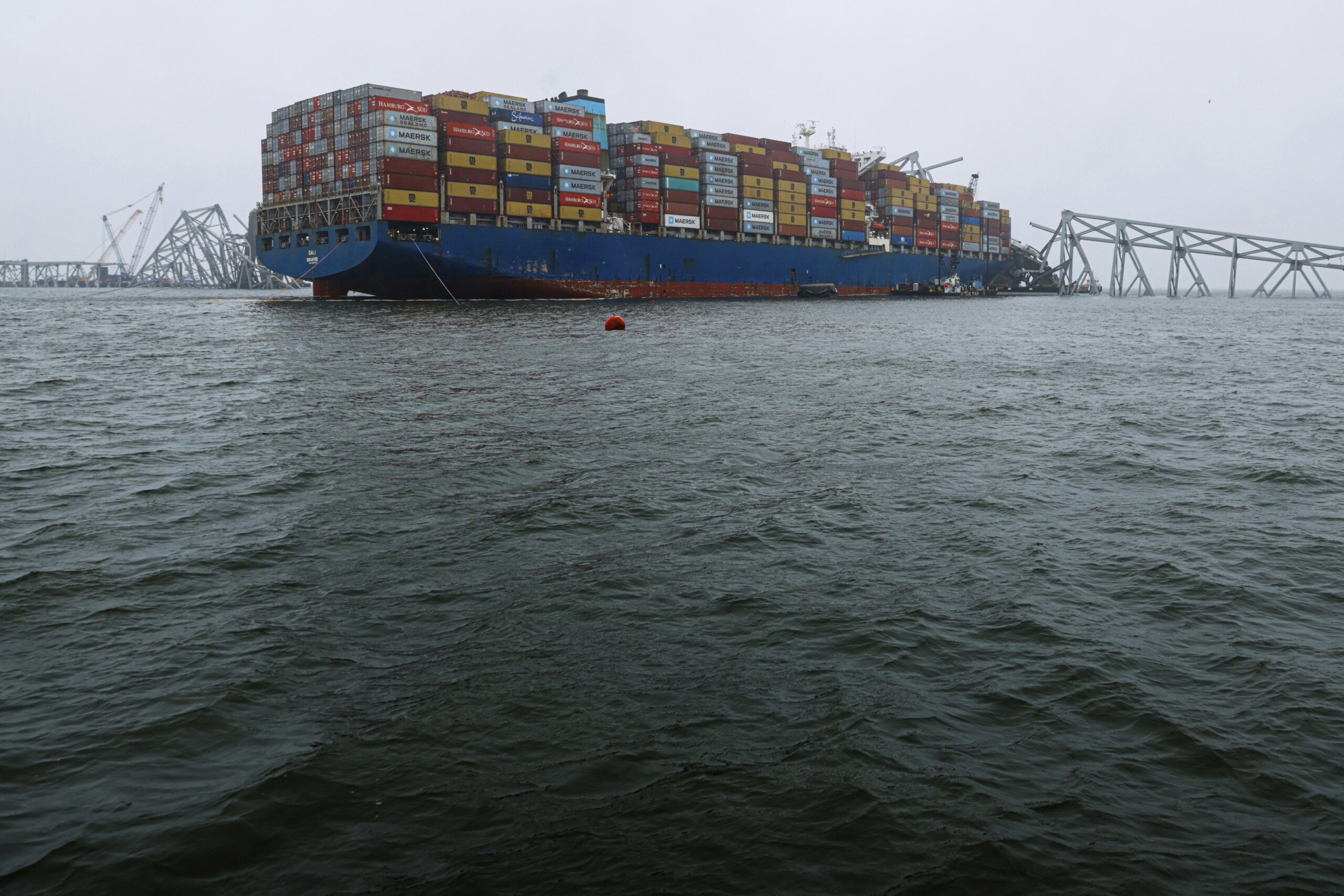
Federal loans became available through the Small Business Administration for small businesses in the mid-Atlantic affected by the closure of the port of Baltimore, due to the collapse of the Francis Scott Key Bridge.
The SBA opened a Business Recovery Center in Dundalk on Monday.
Maryland Gov. Wes Moore had requested a disaster declaration by the SBA, which has been granted.
One of the last drivers to cross Baltimore’s Key Bridge, this man is ‘thankful’ to be alive
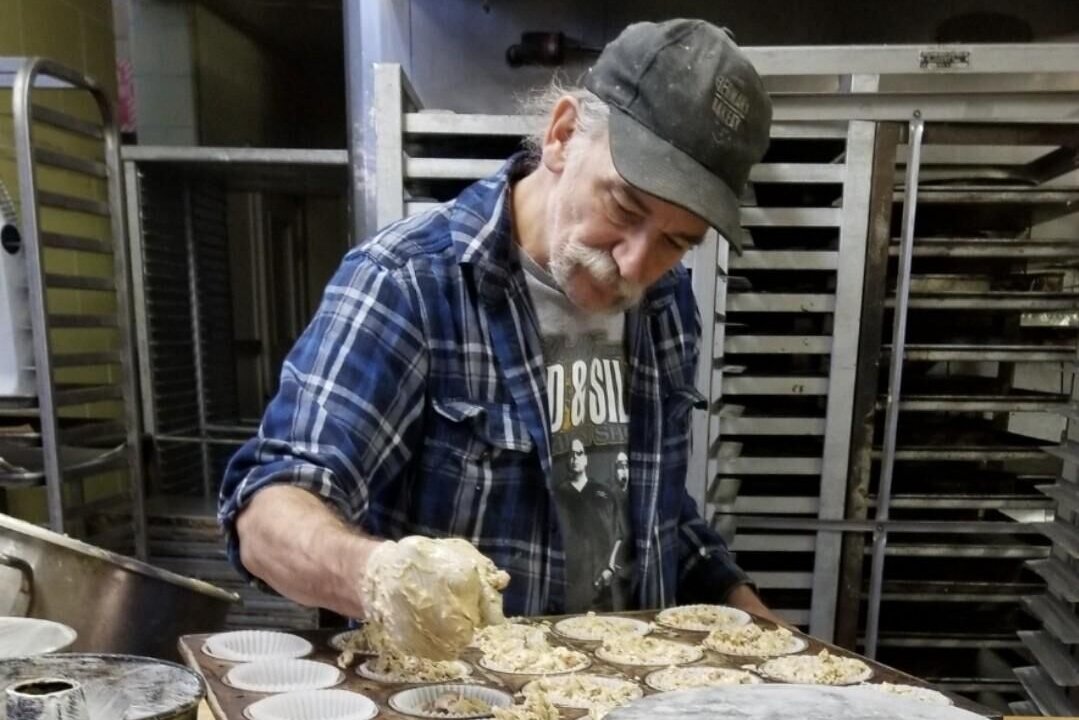
As the loss of six construction workers emphasized the tragedy of Baltimore’s Francis Scott Key Bridge collapse, one man who traveled the bridge just minutes before a cargo ship crash brought it down says he is “thankful that he’s still here.”
“If I had been another … minute, I may not be here talking to you,” Larry DeSantis told WTOP.
DeSantis was headed to one of his bakery jobs to the next on the night of the collapse, and says he was one of the last cars to cross the bridge before it fell.
Construction workers honor Key Bridge collapse victims
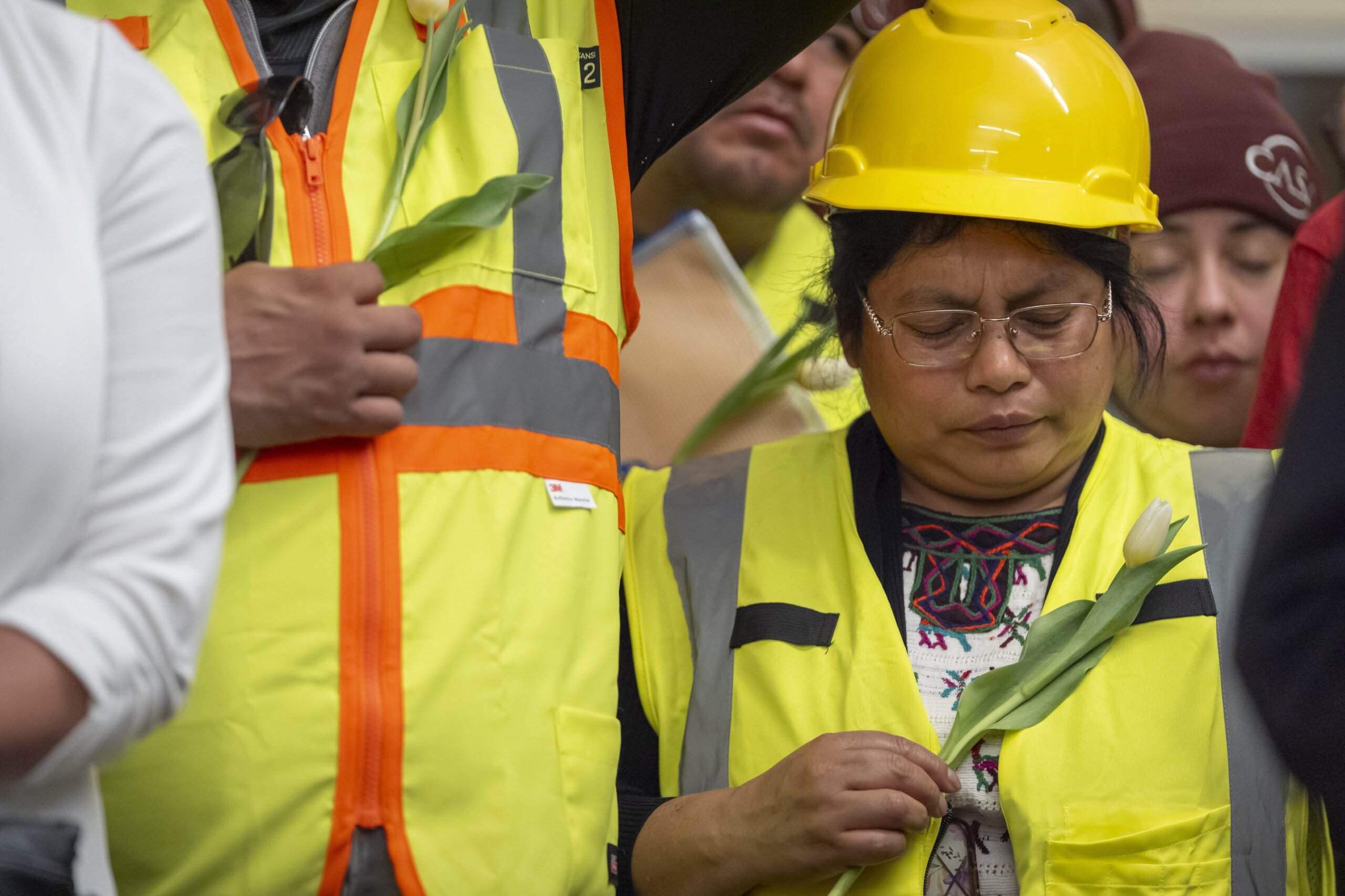
While holding flowers and wearing construction hats and yellow or orange vests, Maryland construction workers on Friday honored their peers who died when Baltimore’s Key Bridge collapsed this week.
After praying for healing and safety, the community workers, some of whom are members of the immigrant rights group CASA, recalled some of the dangers they have experienced in their jobs.
They described the risks they face every day simply by going to work, and considered that it could have been them repairing potholes on the bridge when the Dali cargo ship struck it.
Building a new Key Bridge could take years and cost at least $400 million, experts say
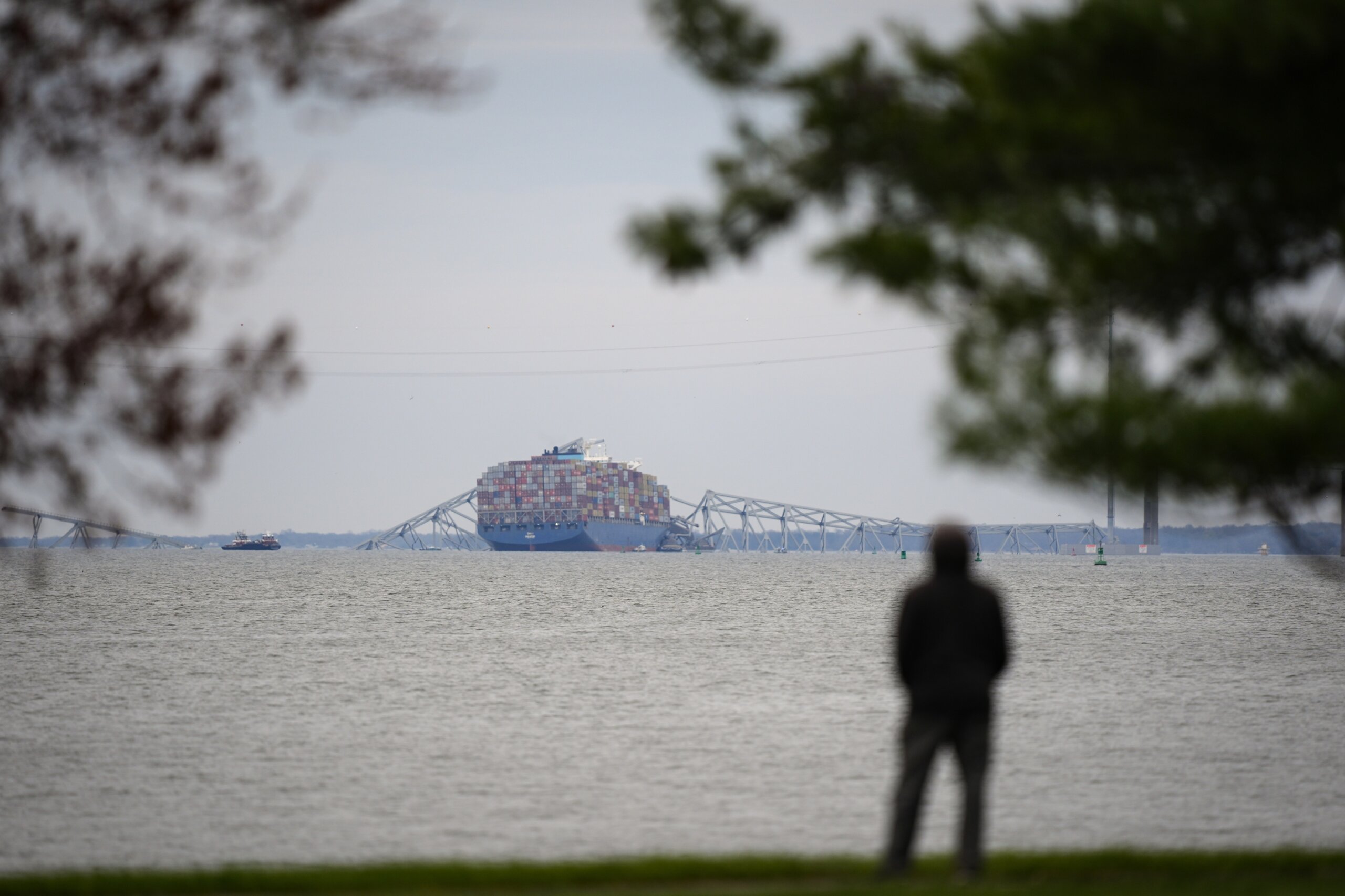
Rebuilding Baltimore’s collapsed Francis Scott Key Bridge could take anywhere from 18 months to several years, experts say, while the cost could be at least $400 million — or more than twice that.
It all depends on factors that are still mostly unknown. They range from the design of the new bridge to how swiftly government officials can navigate the bureaucracy of approving permits and awarding contracts.
Realistically, the project could take five to seven years, according to Ben Schafer
, an engineering professor at Johns Hopkins University.
“The lead time on air conditioning equipment right now for a home renovation is like 16 months, right?” Schafer said. He continued: “So it’s like you’re telling me they’re going to build a whole bridge in two years? I want it to be true, but I think empirically it doesn’t feel right to me.”
Others are more optimistic about the potential timeline: Sameh Badie, an engineering professor at George Washington University, said the project could take as little as 18 months to two years.
Biden OKs $60M in aid after Baltimore bridge collapse as governor warns of ‘very long road ahead’
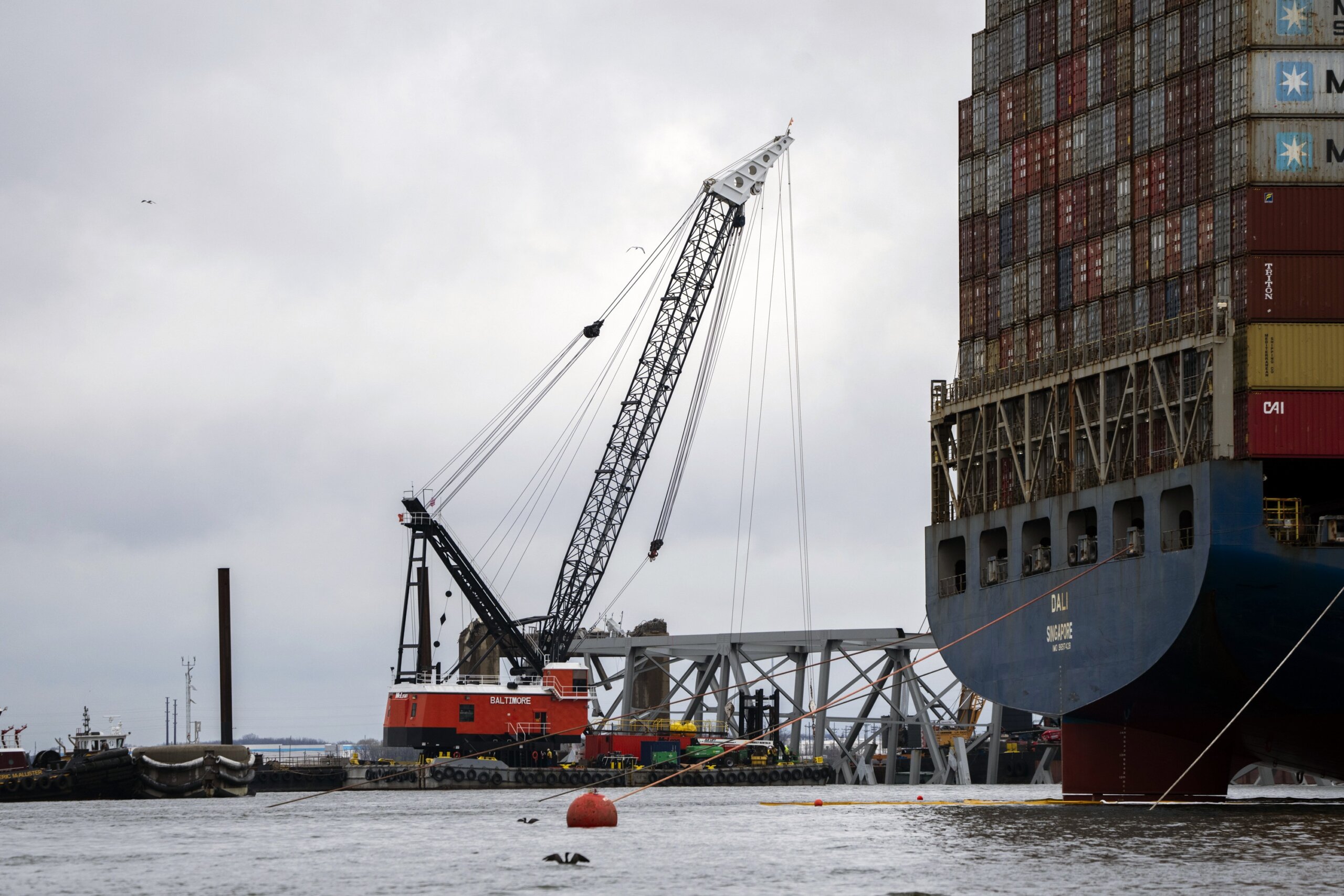
Maryland Gov. Wes Moore warned of a “very long road ahead” to recover from the loss of Baltimore’s Francis Scott Key Bridge as the Biden administration approved $60 million in immediate federal aid after the deadly collapse.
President Joe Biden has pledged the federal government would pay the full cost of rebuilding the bridge.
The state is “deeply grateful” for the federal funds and support, Moore said. “This work is not going to take hours. This work is not going to take days. This work is not going to take weeks,” Moore said. “We have a very long road ahead of us.”
Central American and Mexican families mourn the workers lost in the Baltimore bridge collapse
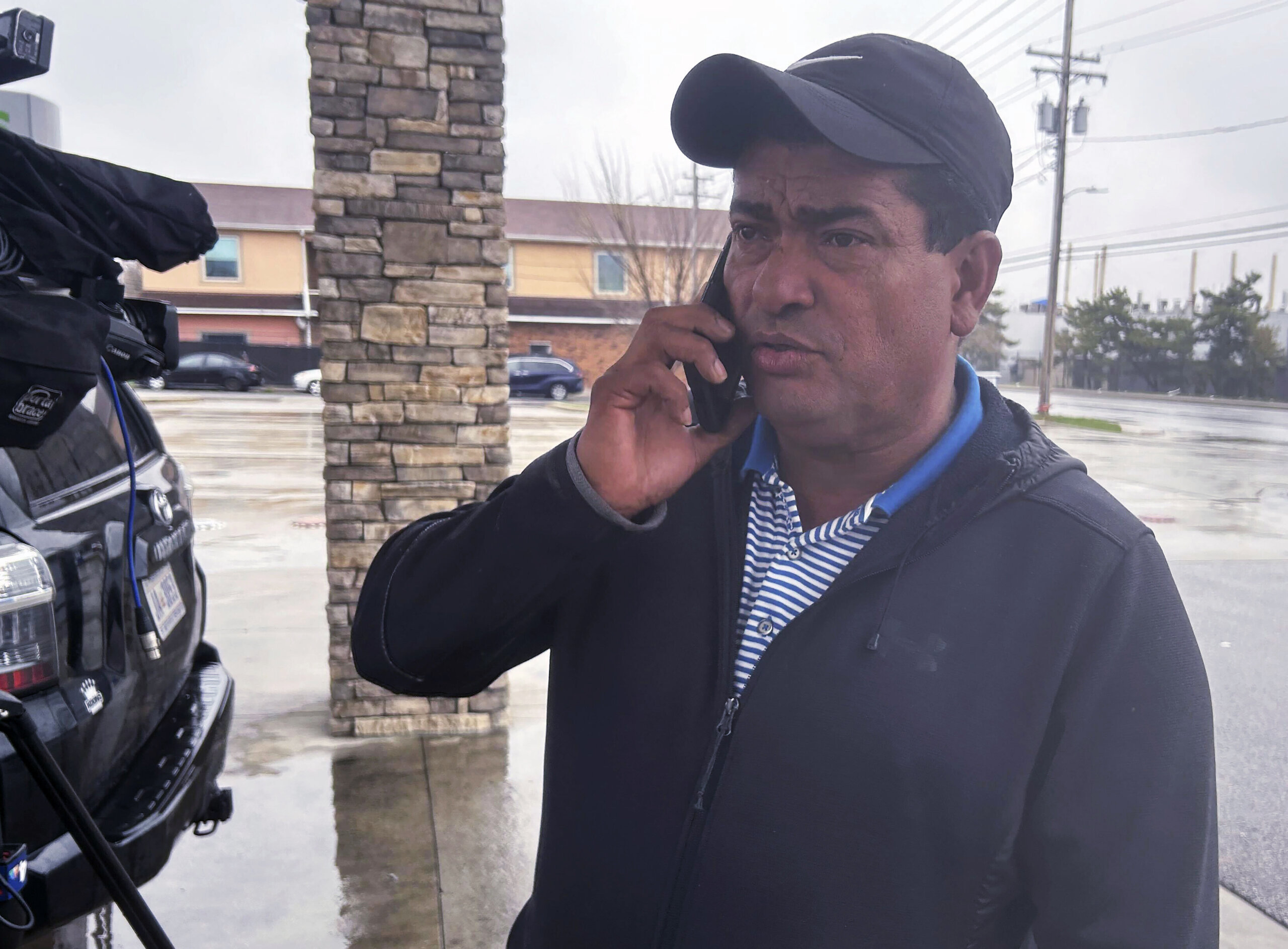
The construction workers who went missing in the Baltimore bridge collapse came to the Maryland area from Mexico or Central America, including an enterprising Honduran father and husband who started a delivery business before the pandemic forced him to find other work, according to his family.
Police managed to close bridge traffic seconds before a cargo ship slammed into one of the Francis Scott Key Bridge’s supports early Tuesday, causing the span to fall into the frigid Patapsco River. There wasn’t time for a maintenance crew filling potholes on the span to get to safety.
At least eight people fell into the water and two were rescued. Two bodies were recovered Wednesday and four remained missing and were presumed dead.
The governments of Mexico, Guatemala, El Salvador and Honduras confirmed that their citizens were among the missing.
Remains of 2 people recovered after Baltimore Key Bridge collapse
By Jessica Kronzer, Thomas Robertson and Abigail Constantino
Searchers recovered the remains of two people from the Patapsco River after a massive container ship crashed into the Francis Scott Key Bridge in Baltimore on Tuesday morning.
The discovery came amid a daylong search for at least six people — all part of a construction crew that was repairing potholes on the Maryland bridge — who plunged into the murky waters after the ship collided with one of the structure’s pillars, sending the bridge tumbling down in a matter of seconds.
Col. Roland Butler, with Maryland State Police, said that a team of divers made the “tragic finding” before 10 a.m.: They found a red pickup truck submerged in about 25 feet of water with two bodies trapped inside.
The victims have been identified as Alejandro Fernandez Fuentes, 35, of Baltimore, and Dorlian Ronial Castillo Cabrera, 26, of Dundalk. Fuentes was originally from Mexico, while Cabrera was from Guatemala.
Drivers assess wreckage while search for bodies of 6 workers continues

One day after a powerless cargo ship rammed into the Francis Scott Key Bridge in Baltimore, causing to crumble, underwater crews are assessing the debris left behind in the Patapsco River while other divers continue to search for the bodies of six construction workers who were on the bridge when it collapsed.
The U.S. Coast Guard suspended its search and recovery operation for the workers at 7:30 p.m. Tuesday, saying that due to the amount of time that had elapsed since the initial collapse and the cold water temperatures, they did not expect to find any of the workers alive. Unchanged: The U.S. Coast Guard suspended its search and recovery operation for the workers at 7:30 p.m. Tuesday, saying that due to the amount of time that had elapsed since the initial collapse and the cold water temperatures, they did not expect to find any of the workers alive.
Even though the operation has shifted away from search and rescue, Maryland Gov. Wes Moore said Wednesday morning there’s still a sense of urgency in the recovery mission.
“The top priority for me right now is still the recovery, we’ve got to bring these families closure,” Moore said Wednesday.
6 construction workers presumed dead after Baltimore Key Bridge collapse, Coast Guard says
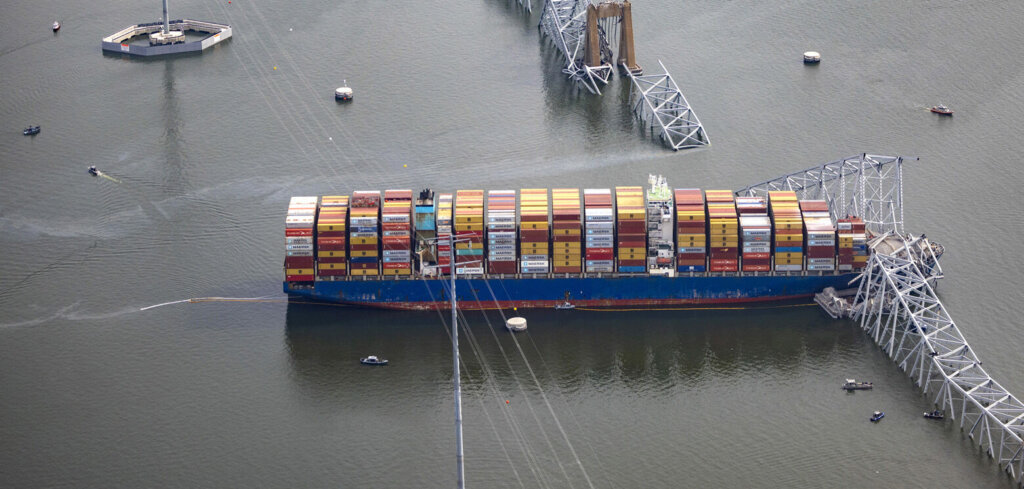
By Ciara Wells and Jessica Kronzer
Six construction workers who were on Baltimore’s Francis Scott Key Bridge at the time it was rammed by a cargo ship, causing the bridge to collapse, are presumed dead after a search and rescue operation that lasted nearly 18 hours, the U.S. Coast Guard said Tuesday night.
Reports came in around 1:40 a.m. Tuesday that a large vessel crashed into a column in the central part of the bridge that carries north and southbound lanes of Interstate 695.
The ship caught on fire, with dark smoke billowing out of the vessel, before it crashed into the support structure.
Baltimore bridge collapse and port closure send companies scrambling to reroute cargo
The stunning collapse of Baltimore’s Francis Scott Key Bridge is diverting shipping and trucking around one of the busiest ports on America’s East Coast, creating delays and raising costs in the latest disruption to global supply chains.
After the container ship Dali hit the bridge and brought it down, ship traffic entering and leaving the Port of Baltimore was suspended indefinitely. That will require rerouting vessels or their cargo to other ports, potentially causing congestion and delays for importers.
‘I just heard this great big noise’: Md. neighbors recall moment Baltimore’s Key Bridge fell
Dozens of people kept ignoring the “no parking” signs that line Dundalk Avenue to get out of their cars and look beyond the Port of Baltimore toward the Francis Scott Key Bridge — or at least where the Key Bridge is supposed to be.
From there you can see some of it, but the great arching bridge that’s part of the skyline in Baltimore is missing, and even those who heard the crash as it happened overnight had to show up to stare, seeing what they never believed they had heard.
“I was up and I just heard this great big noise and rumbling sound, and I thought it was something going on down my road, so I got up out of my chair and walked outside and there was nothing,” said Frank Wolfe, who lives in Dundalk.
Only when he woke up later on in the morning did he put two and two together.
Listen to what people say they heard in the wee hours of the morning, when a massive container ship hit the bridge and what they saw unfold afterward.
Francis Scott Key Bridge in Baltimore collapses after ship struck it, sending vehicles into water Content
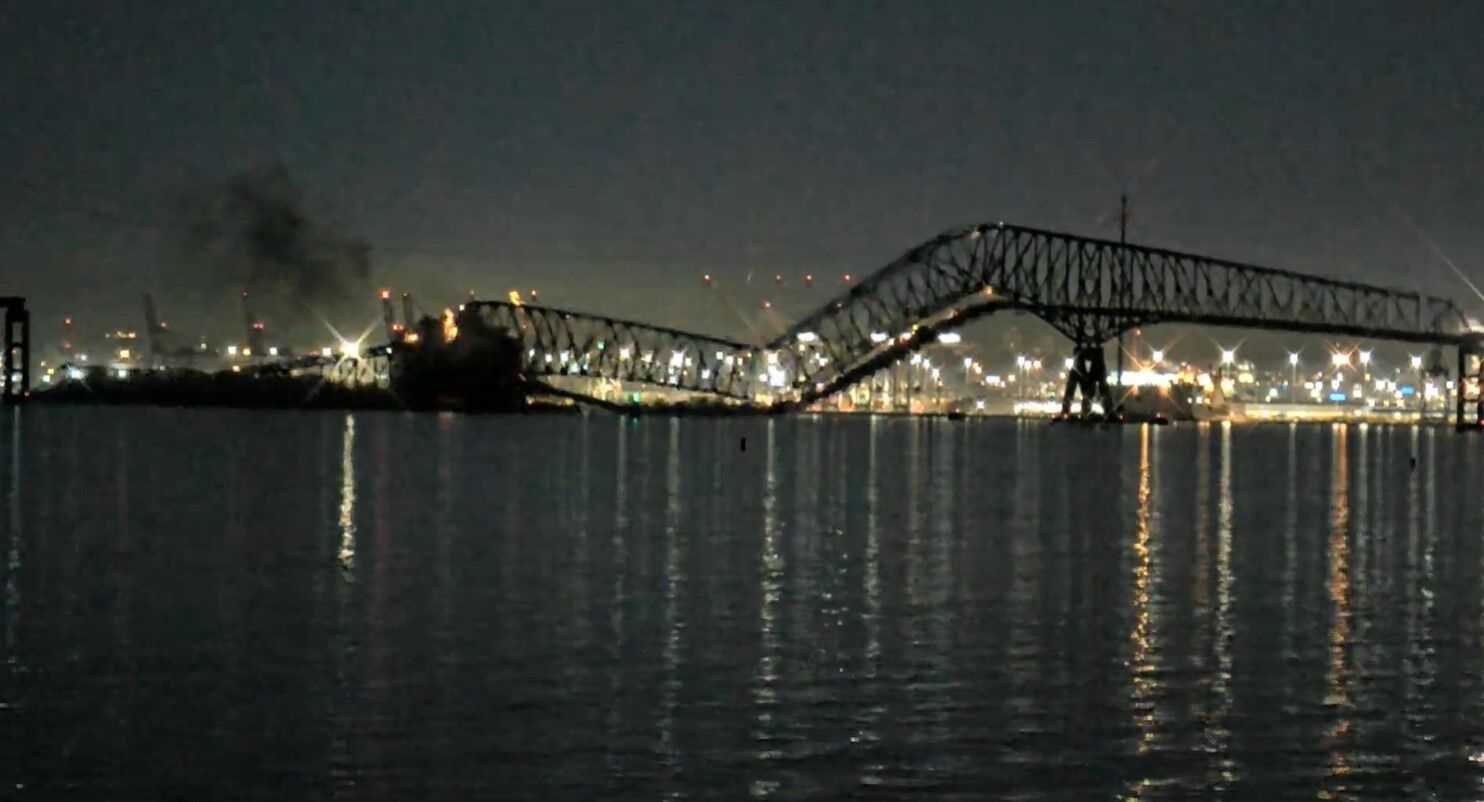
The Francis Scott Key Bridge in Baltimore, Maryland, has collapsed after a large container boat collided with it early Tuesday morning.
Reports came in around 1:30 a.m. Tuesday that a large vessel crashed into a column in the central part of the bridge carrying north and southbound lanes of Interstate 695, catching on fire before causing multiple vehicles to fall into the Patapsco River below.
Rescuers were searching for at least seven people in the water.
“This is a dire emergency,” said Kevin Cartwright, with the Baltimore City Fire Department. “Our focus right now is trying to rescue and recover these people.”
